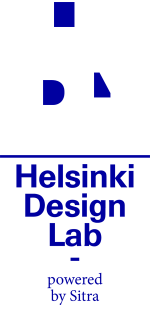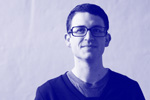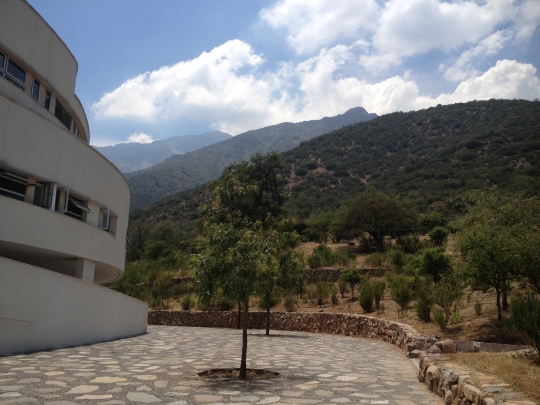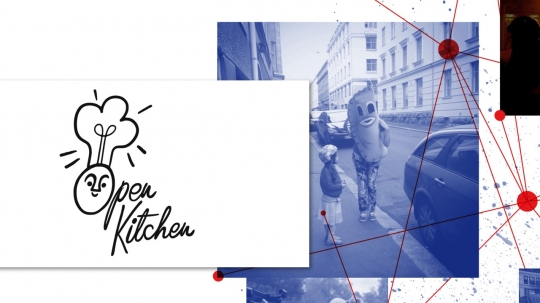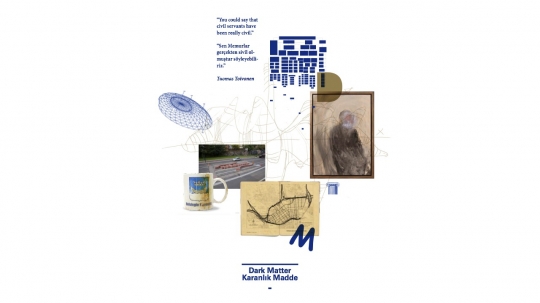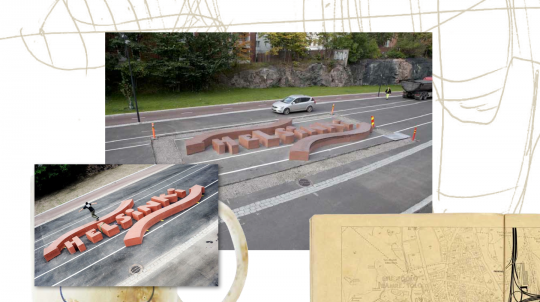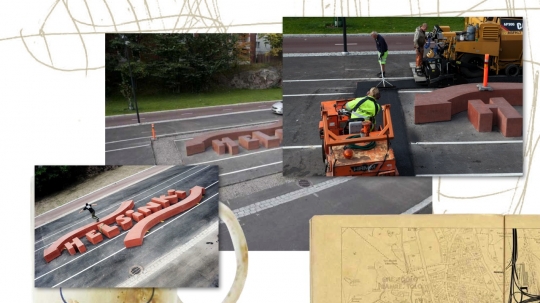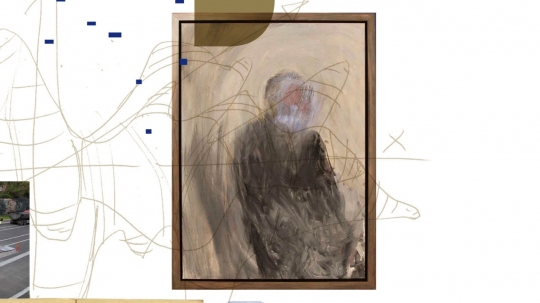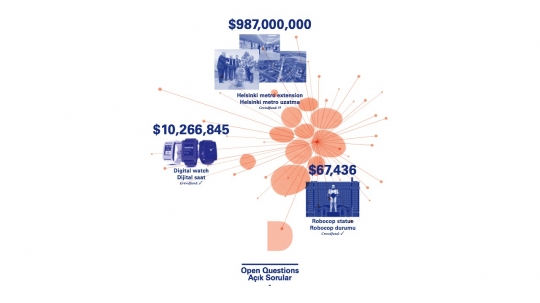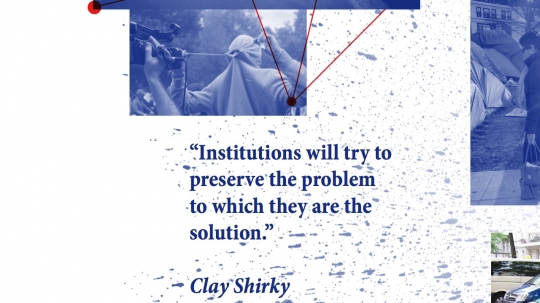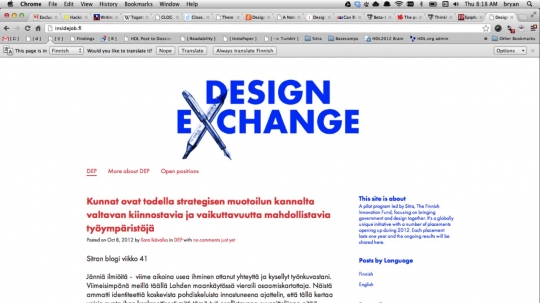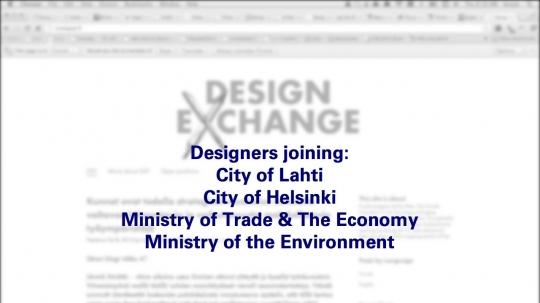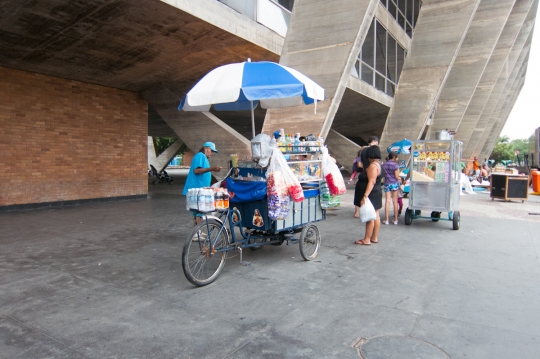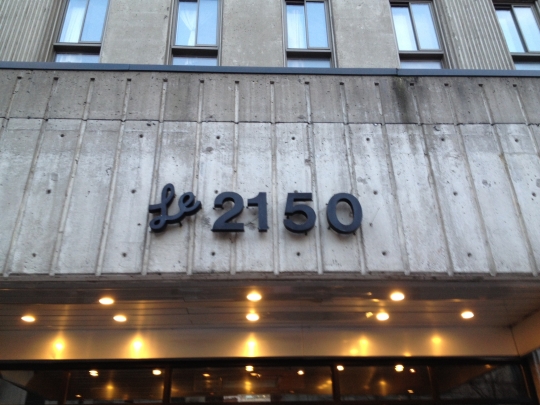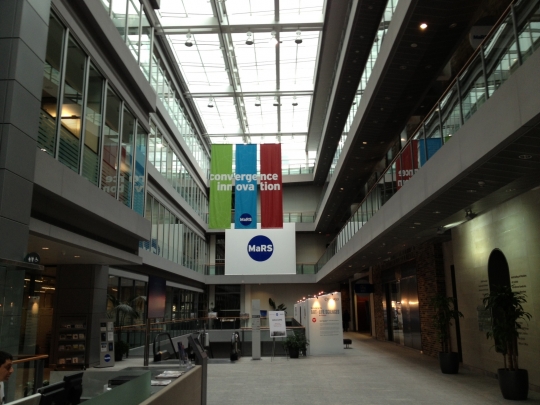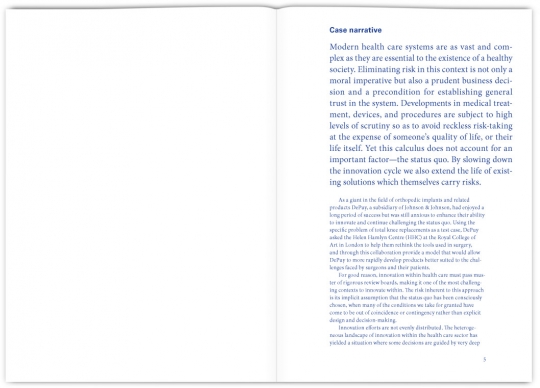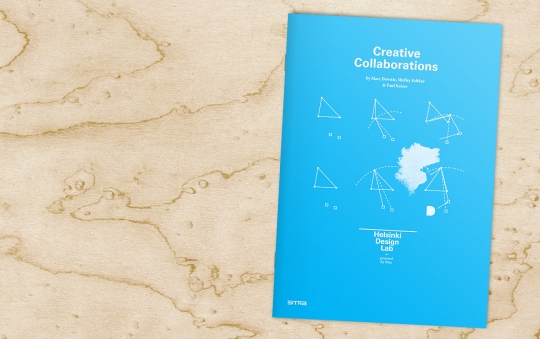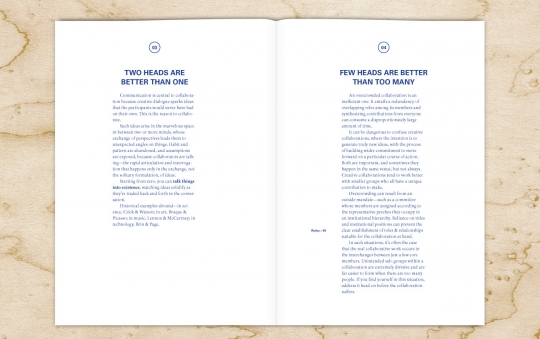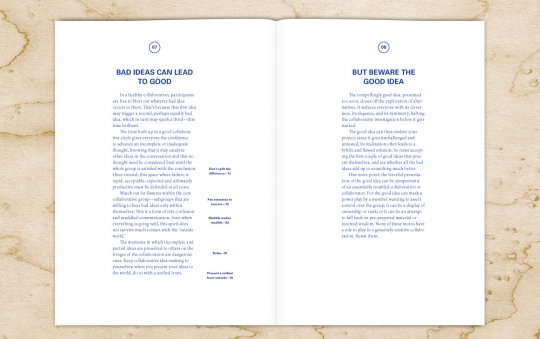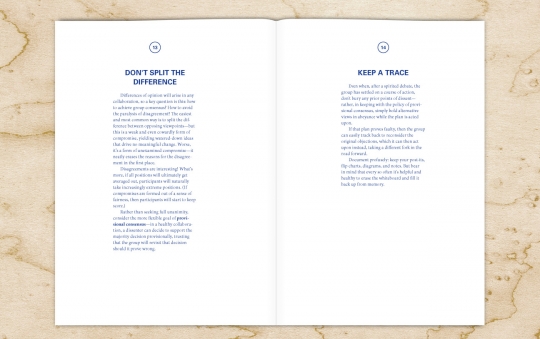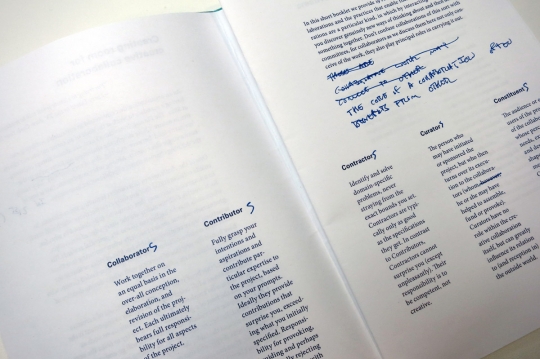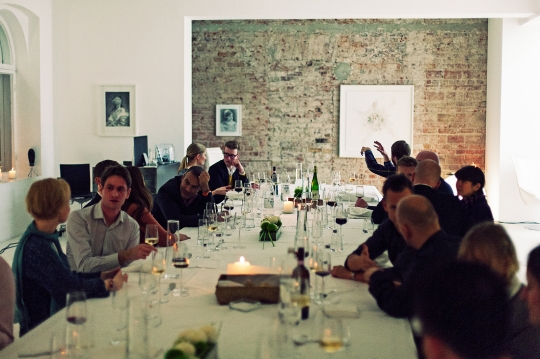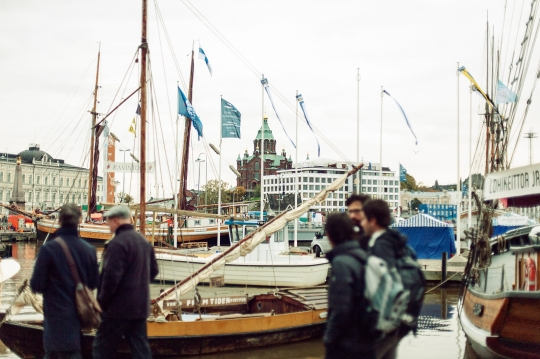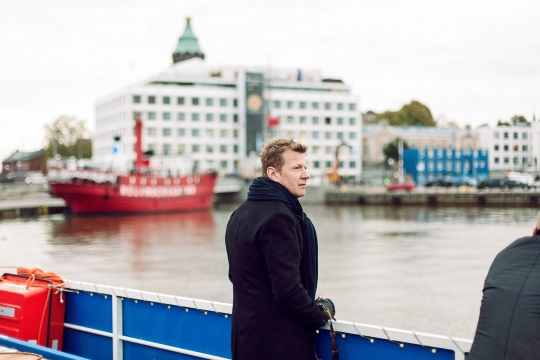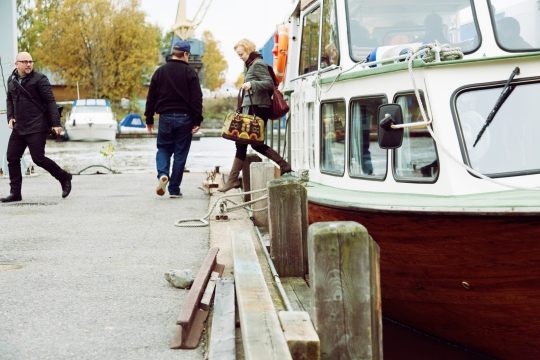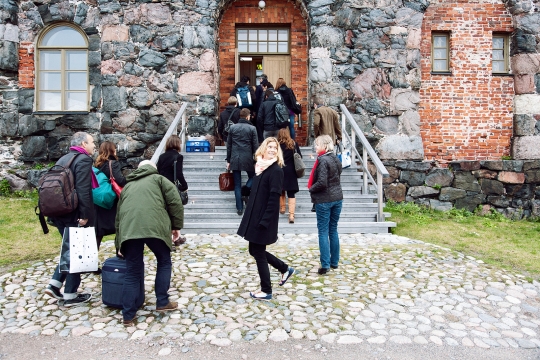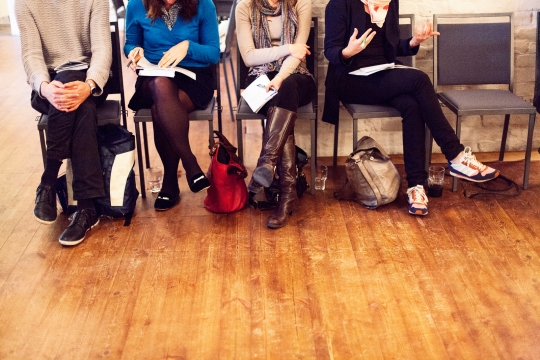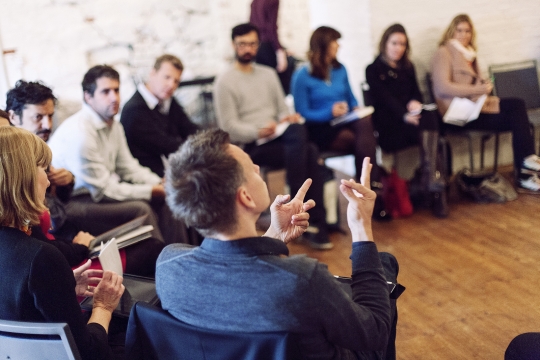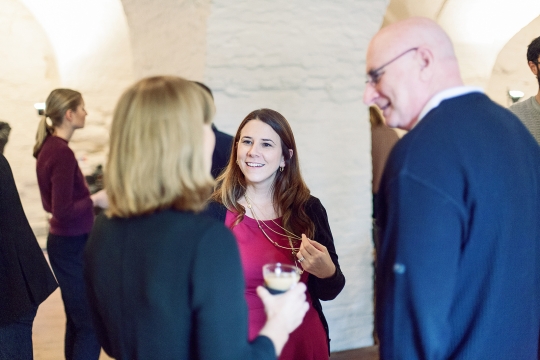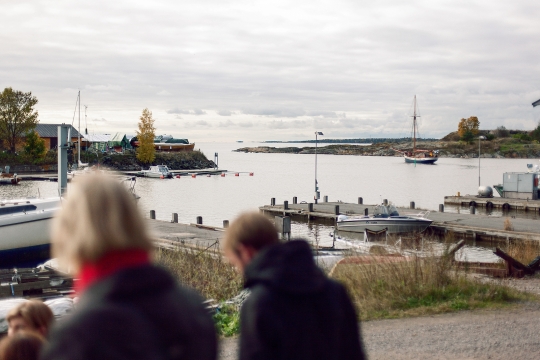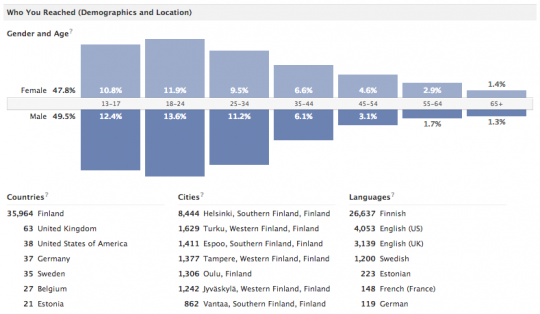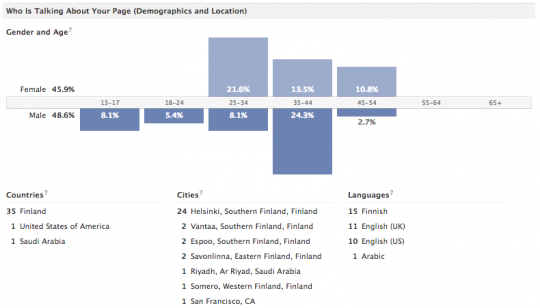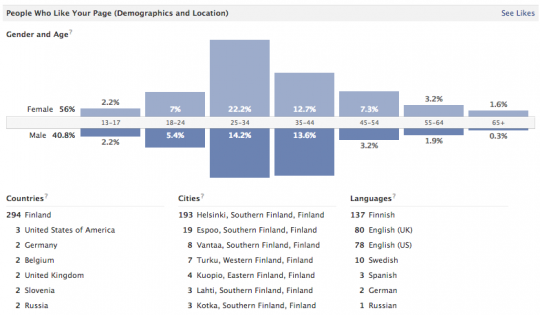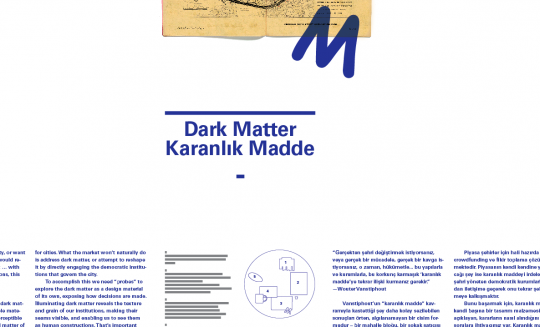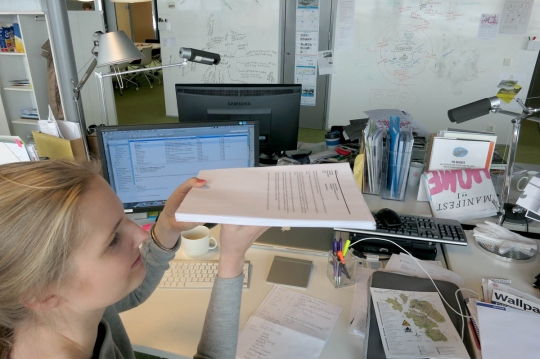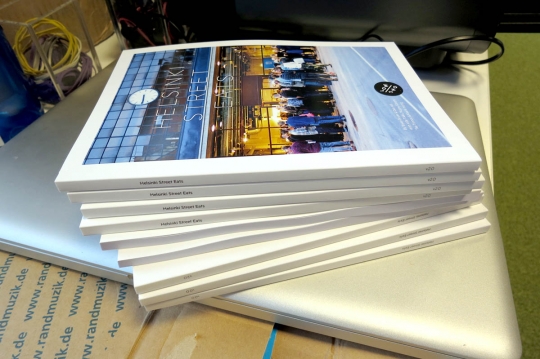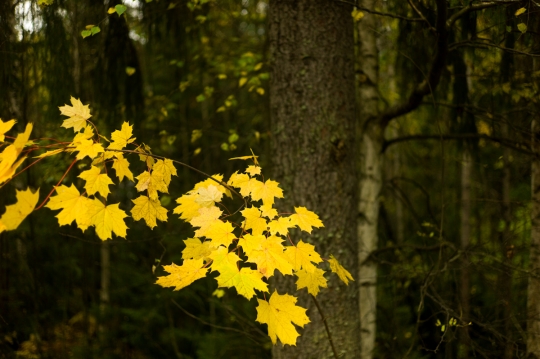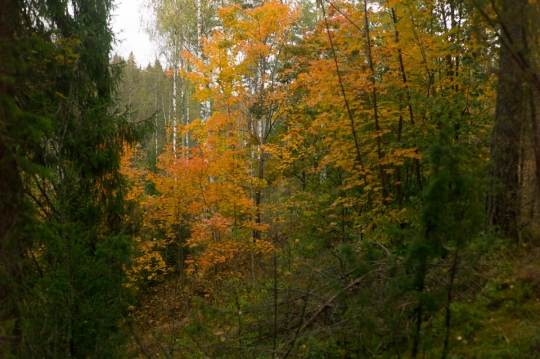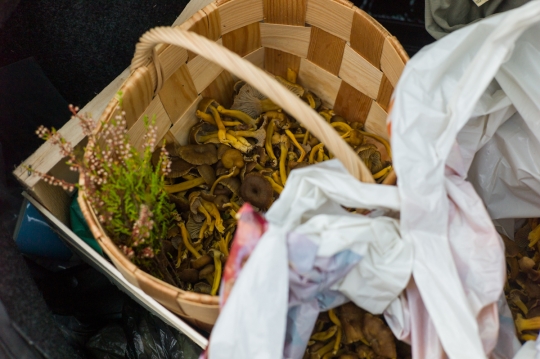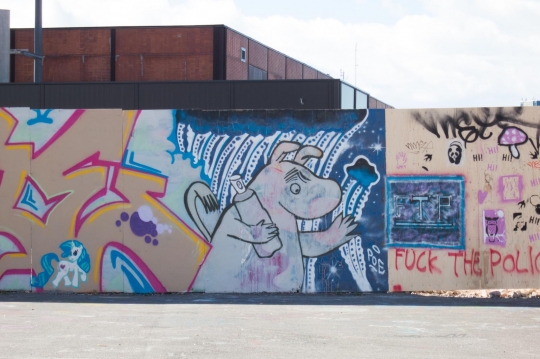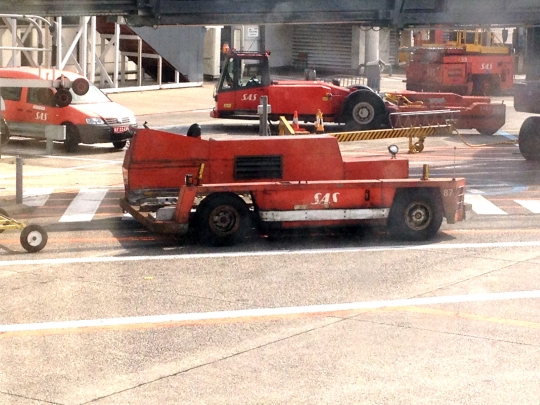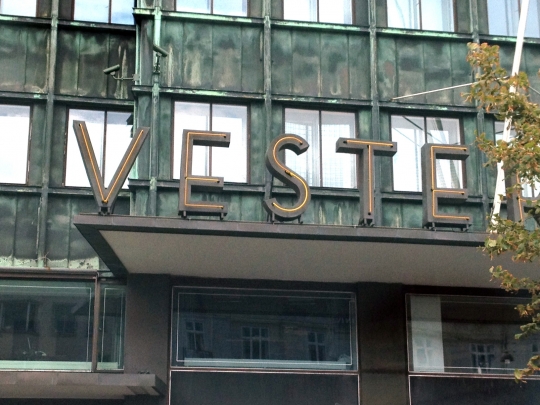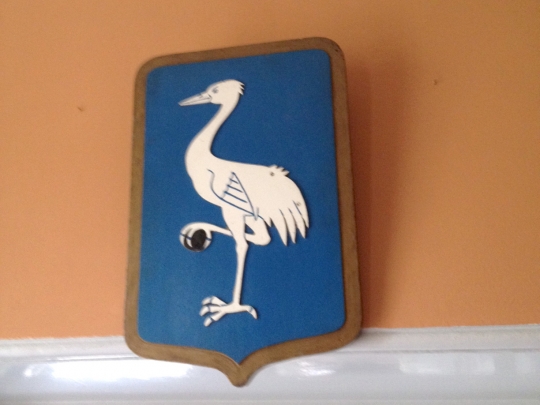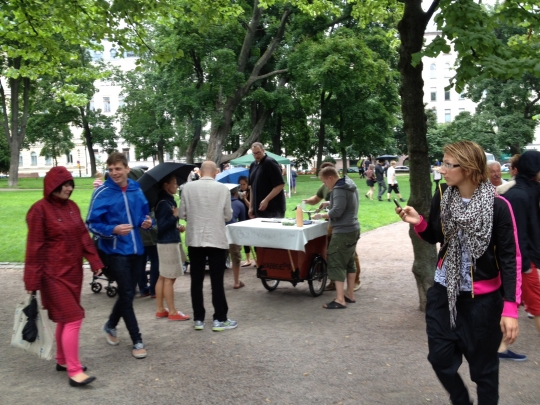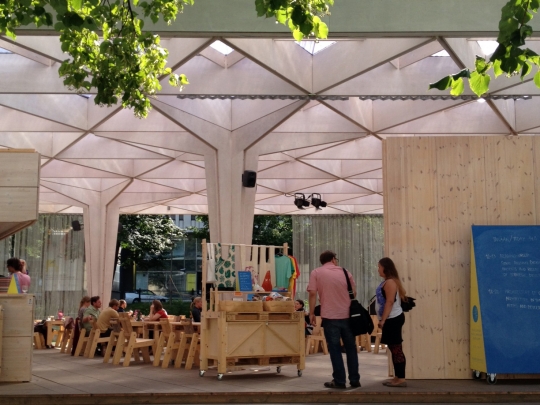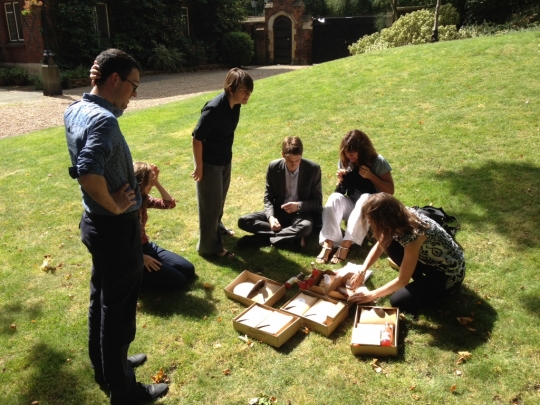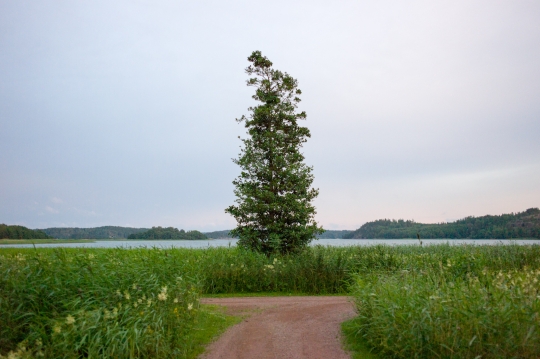All posts by Bryan Boyer
In another window I'm working on a draft of the feedback form we will send to the 12 Open Kitchen participants. That makes this weeknote a procrastination technique. Again.
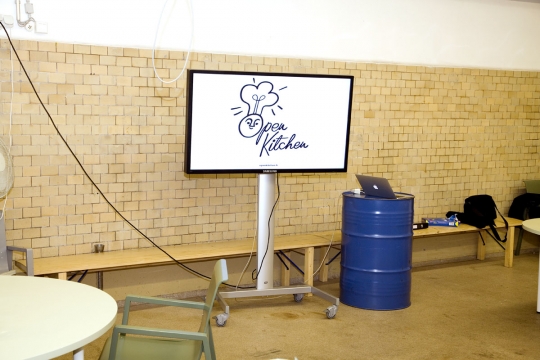
A snapshot from the opening of Open Kitchen. And a bunch more photos below. Photo: Matti Tanskanen
We've been heads down these last three weeks.
Maija and I are working on a publication to wrap-up the work on Brickstarter. Sitra's not in a position to build the whole platform ourselves at the moment (though we are probably building a nano-micro-proto), so we're transferring our momentum there into a publication that coalesces three things: urbanism, governance, and emergent initiatives (or perhaps Peer Progressivism?). The goal of the publication is to simmer down our blog a bit and prepare a limited primer on these issues that will hopefully benefit anyone interested in building a platform to support bottom-up urbanism, and perhaps people who are using such platforms to build the city.
A recent call with Dan Parham, co-founder of Neighborland, helped clarify my thinking around the next steps for Brickstarter. As Dan Hill and I have always tried to emphasize when showing the Brickstarter mockups, the ideas are not the hard part necessarily, so I've been a bit embarrassed by the press our project has received because the attention should really be directed to Neighborland and others who are putting the ideas into practice.
Since we don't have a live platform we haven't been prototyping with users, but we have been prototyping with another group: civil servants. The reason we jumped right to high resolution mockups is so that they're plausible, and perhaps even a little scary, when we show them to our colleagues in city hall and elsewhere. Part of our challenge has been to find a language and a narrative that helps the public sector recognize the potential "threat" of citizen-initiated urbanism, and in doing so help them lean into it, rather than shy away. Because, of course, it's not a threat at all—quite the opposite. We're getting close to having an agreement with a town in eastern Finland to put a subset of the Brickstarter ideas into practice.
After talking with Dan, I'm retooling my thinking on the publication a bit and focusing more on how our work might offer a language and narrative that helps others build the connective tissue between government, citizen groups, and the technologists who build collaboration platforms. If we can do that, I would be very happy.
We've brought in Rory Hyde to help us as an editor for the Brickstarter wrap-up. It's great to have him, not only because his own work on unsolicited architecture overlaps with Brickstarter, but because he also brings structure to our work. Thanks to Rory's careful work on the table of contents and overall structure I'm now hyper conscious of the fact that our introduction is 35% too long. Time to lose 1000 words. This is my favorite part (really).
Maija's working on some text to summarize the Fact Cards, as well as a set of diagrams that map them out relative to each other. We'll crunch on this right up till the end of the year, but I'm resolved to have the final draft of the manuscript done by the new year.
Marco was in Chile to give a talk at the Architecture Biennale there, and a number of other things. He reports back that it's an exciting moment in Chile, but then again readers of this blog know that we're fans of the strategic design work happening in that country.

Marco was quite happy about summer in December.
Justin was in town for a week, wherein he and Marco spent a good portion of it sequestered in a conference room hashing out a publication on Low2No. With that project transitioning to our market partners VVO and SRV this is a good moment to step back and reflect on what we've learned. That's the gist of the book, but I'll let Justin introduce it more properly when things are more fixed.
Somehow without trying to we've become a publications house. I'm glad that words are a renewable resource, or we might be in danger of using them all up.
Open Kitchen launched on December 3rd, but I think it's best to start with this, a new video that Kalle and I finished to coincide with the launch:
The Facebook page for the project is the best place to get a sense of how things have been going. Our participants spent about 1.5 weeks learning from experienced food entrepreneurs around the city, then the second 1.5 weeks have been dedicated to figuring our a shared restaurant concept and putting that into motion. Last night I had my second meal at Open Kitchen and it was—forgive me for bragging on behalf of the group—excellent! I'm really proud of what the participants have put together.
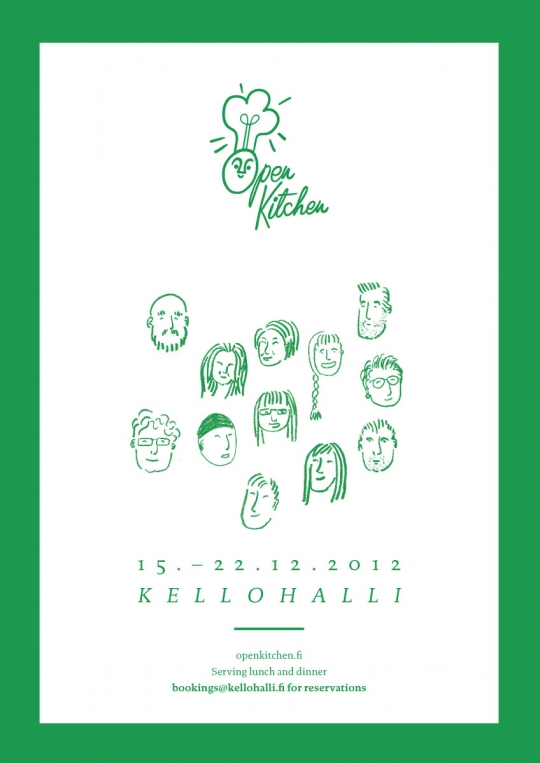
Inka Kosonen and Mari Sollman, two Aalto University Masters students, have been working with the team to create and execute a visual identity for the materials and interior at Open Kitchen… all in 3 days.
With things running more or less smoothly, we're now turing our focus to next steps for the programme. In January we'll be hosting some sessions to see if we can match the programme with a funder who would be interested in taking it forward on an ongoing basis. From this perspective, we've treated Open Kitchen as a mechanism to produce evidence. It is testing the viability and usefulness of a 3 week course as well as proving the market for such a thing. Sitra has taken the upfront risk in hopes that we will find a partner to carry it forward. That's always easier with even a modicum of evidence.
There will be more to say, but for now I'm going to end this post with some photos that document the first 2 weeks of Open Kitchen.

Tuuli Kaskinen of Demos Helsinki talking about food sustainability.
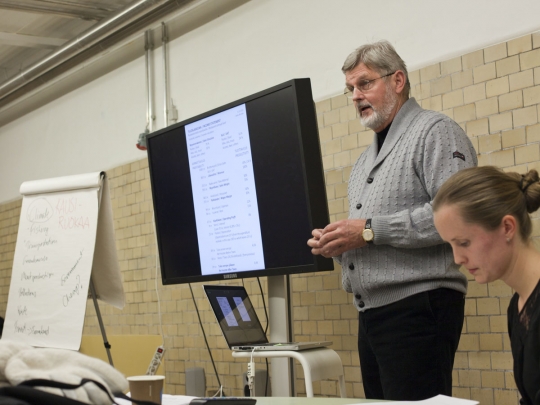
Aimo opened his first restaurant for the Olympics in 1952.

Cynthia Shanmugalingam of Kitchenette talks about food trends in London. Photo: Matti Tanskanen
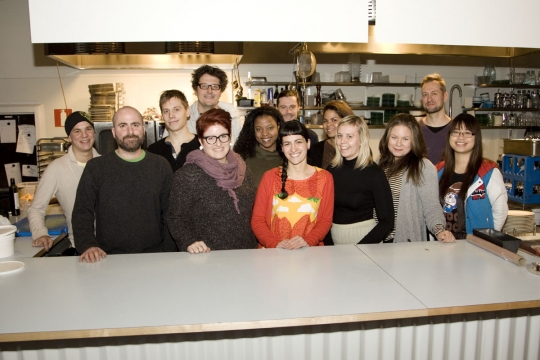
The team! Photo: Matti Tanskanen
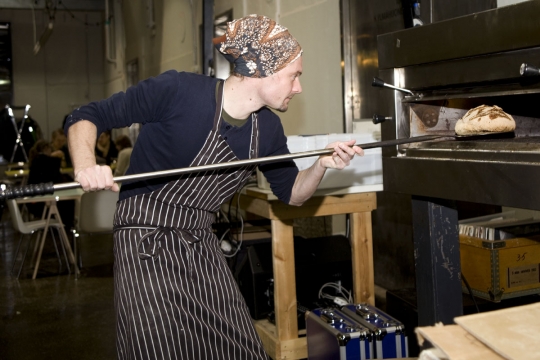
Jérôme putting bread in the oven. Photo: Matti Tanskanen
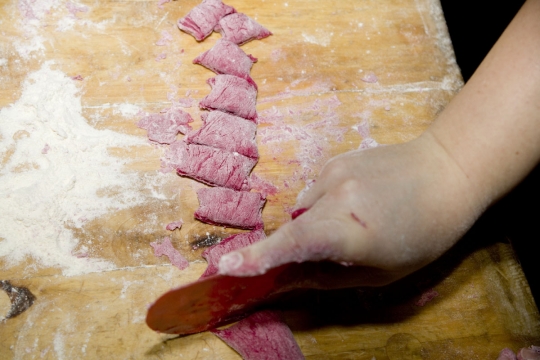
Beetroot gnocchi in the making. Photo: Matti Tanskanen
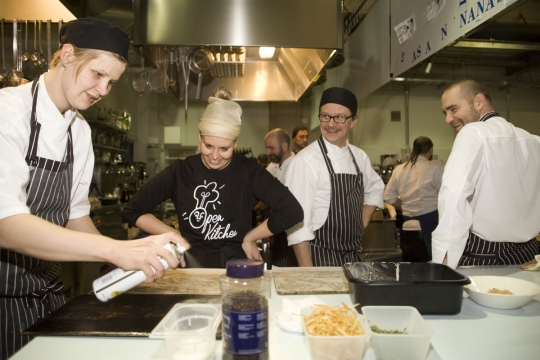
Saila working with the Marrot team in the kitchen. Photo: Matti Tanskanen
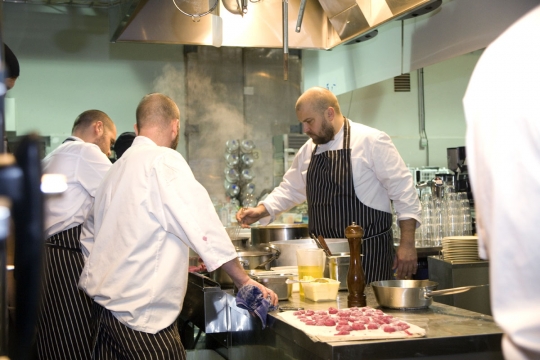
Antto doing this thing. Photo: Matti Tanskanen

A simple, pleasant nordic interior. Photo: Matti Tanskanen
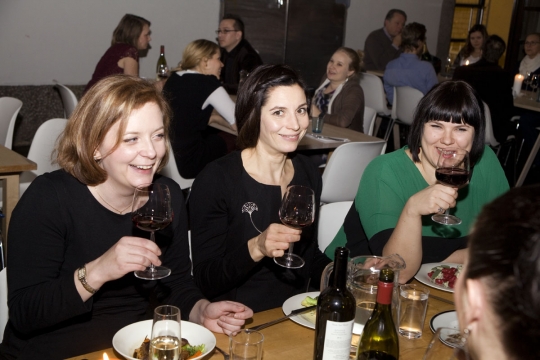
Happy customers! Photo: Matti Tanskanen
Between all of this, Marco, Justin, and I have been finalizing the goals for HDL 2013. I think we have a shared understanding of the goals now, but more on that in the new year.
Talking to students recently I was asked "what do you really do?" A lot of the work is setting conditions and context so that people can do their thing. Most often this means getting contracts right so that collaborations can set off without friction. Briefings are also of critical importance.
Another big part of what our team does is give expression to things that are otherwise invisible. We do this so that these unseen aspects can become part of our conscious decision-making, and so we can tell stories that help others broaden their decision-making.
Showing our work is not always easy, or at least not in a way that makes it interesting. What we do usually invovles people sitting in a room talking. Sometimes they stand up. Occasionally they scribble things on a whiteboard. So how do you show this in a compelling way—in a way that someone who wasn't there might actually want to pay attention to, and might actually glean something from?
In the spirit of legible practice below you will find the briefing that we sent to the photographer before HDL 2012. To see the outcomes of this brief interpeted by Johannes Romppanen a skillful photographer, you can check our gallery on Flickr or check here.
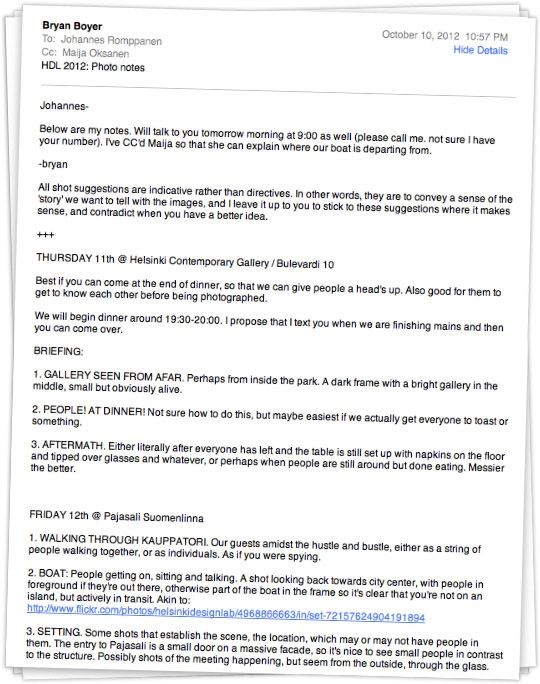
All shot suggestions are indicative rather than directives. In other words, they are to convey a sense of the 'story' we want to tell with the images, and I leave it up to you to stick to these suggestions where it makes sense, and contradict when you have a better idea.
+++
THURSDAY 11th @ Helsinki Contemporary Gallery / Bulevardi 10
Best if you can come at the end of dinner, so that we can give people a head's up. Also good for them to get to know each other before being photographed.
We will begin dinner around 19:30-20:00. I propose that I text you when we are finishing mains and then you can come over.
1. GALLERY SEEN FROM AFAR. Perhaps from inside the park. A dark frame with a bright gallery in the middle, small but obviously alive.
2. PEOPLE! AT DINNER! Not sure how to do this, but maybe easiest if we actually get everyone to toast or something.
3. AFTERMATH. Either literally after everyone has left and the table is still set up with napkins on the floor and tipped over glasses and whatever, or perhaps when people are still around but done eating. Messier the better.
FRIDAY 12th @ Pajasali Suomenlinna
1. WALKING THROUGH KAUPPATORI. Our guests amidst the hustle and bustle, either as a string of people walking together, or as individuals. As if you were spying.
2. BOAT: People getting on, sitting and talking. A shot looking back towards city center, with people in foreground if they're out there, otherwise part of the boat in the frame so it's clear that you're not on an island, but actively in transit. Akin to:
http://www.flickr.com/photos/helsinkidesignlab/4968866663/in/set-72157624904191894
3. SETTING. Some shots that establish the scene, the location, which may or may not have people in them. The entry to Pajasali is a small door on a massive facade, so it's nice to see small people in contrast to the structure. Possibly shots of the meeting happening, but seem from the outside, through the glass.
4. EVENT: Probably best if you sit for a while without taking any photos to let people get used to you being there. But use your judgement. No special directives here, but some shots of people discussing.
5. RING OF CHAIRS. We will have the chairs in a circle. Try to get a shot with the whole ring visible. Otherwise, please grab a series of shots that we can stitch together (I can do it so you're not bothered). This is a theme from last time:
http://www.flickr.com/photos/helsinkidesignlab/4970979696/in/set-72157624904191894/
6. PEOPLE STEALING A MOMENT AWAY: as individuals, pairs, or small groups, people will inevitably sneak away from the main part of the group to discuss something, have a phone call, etc. These are nice moment because they show a bit of humanity. The event is not consuming them. Example: http://www.archdaily.com/141823/mckinsey-company-hong-kong-office-oma/_mg_0127/
7. PROGRAMME BOOKLET: A shot of the book (ideally cover visible) in someone's hand, or just sitting somewhere. But an image of the book. Example: http://www.flickr.com/photos/helsinkidesignlab/6205412773/in/photostream
8. FOOD: food is very important to us because it's a natural opportunity to talk to new people, or change the conversation. So somehow to show that while people are eating, or grabbing food, they are also still "working".
+++
In 1968 Sitra had a design event on Suomenlinna, so this is a bit of a homecoming. Here are the photos from that. They're pretty amazing.
Photos from a previous event that we like:
http://www.flickr.com/photos/helsinkidesignlab/4968872519/in/set-72157624904191894
http://www.flickr.com/photos/helsinkidesignlab/4968684851/in/set-72157624904191894
http://www.flickr.com/photos/helsinkidesignlab/4969305960/in/set-72157624904191894
http://www.flickr.com/photos/helsinkidesignlab/4968855619/in/set-72157624904191894
http://www.flickr.com/photos/helsinkidesignlab/4970368253/in/set-72157624904191894/
http://www.flickr.com/photos/helsinkidesignlab/5032513281/in/set-72157624904191894
http://www.flickr.com/photos/helsinkidesignlab/5032520997/in/set-72157624904191894
http://www.flickr.com/photos/helsinkidesignlab/5033150866/in/set-72157624904191894
http://www.flickr.com/photos/helsinkidesignlab/5032536739/in/set-72157624904191894
http://www.flickr.com/photos/helsinkidesignlab/5032533765/in/set-72157624904191894
And something random but nice:
http://www.kinfolkmag.com/storage/journal/091912foodrenaissance/food-renaissance-2.jpg
In the grand scheme of our work, photography briefings are not among the most critical things that we do. But given that this was sitting in my email and it might be of use to someone somewhere I figured, why not, let's see what the internet finds to do with this.
Note: Lately I've been returning to the habit of writing prepared remarks in an effort to stick to the strict time limits of various events. As an added bonus, this means I end up with a transcript that can be posted with relative ease. Below is one such example, originally presented at the World Design Forum (previously mentioned here) on October 19th in Eindhoven and curated by the indefatigable intellect of John Thackara. Attentive readers will notice that the starting point shares something with an earlier post, but it quickly diverges. And so...
I'm an optimistic enough to believe that humanity will find a way to weather the immense and multiple crises that are mounting today. I'm less optimistic for our institutions, however, and this is why I've chosen to practice design inside a government agency. I believe that our institutions are outdated technology and that the tools and attitudes of design are part of the fix.
At Sitra we've been testing this notion since 2009 with Helsinki Design Lab. We have projects at different scales, from 10s of thousands of euros to tens of millions.
On the small end, that includes projects like Open Kitchen, which is a bootcamp for food entrepreneurs. We've had an explosion of pop-ups thanks to Restaurant Day, a festival that happens 4 times a year which you can see an image of here.
But what pops up inevitably pops down. Open Kitchen is designed to fill a missing rung on the ladder of innovation. In doing so we hope to help restauranteurs move from pop-up to permanence. This is important because we want to combine the faster cycle speed of pop-up innovation with the reliability of everyday businesses.
On the bigger end of the spectrum, we do things like Low2No, a sustainable urban development project that looks like a block of 5 buildings, but it's actually a vehicle to work with the ministries, the city, and private developers to create climate friendly regulations and business models. We use the messy reality and imperative of the construction project to bring urgency to regulatory change.
One early success has been a change to the fire codes to make it legal to build large buildings out of timber—something we had never expected when we began but discovered and acted on along the way. We call it a success because 4 other timber buildings have been announced since the change, so this is early but important evidence of scale.
What links both of these is an interest in using tangible projects to help organizations, as Jan Van Der Kruis noted earlier, to "witness change."
We have not designed roads to have traffic jams, hospitals to have queues, services to remove personal agency, and tax forms to be confusing. Institutions and their procedures can appear immutable and static, but they are nothing more than an accumulation of human choices. We can make difference choices today, and have different institutions tomorrow.
To do so, we need to develop ways to grapple with something that Dutch architectural historian Wouter Vanstiphout calls "Dark Matter". It's a metaphor for the complexity of institutions: all of the invisible things like incentives, pay grades, organizational culture, and other issues that nevertheless shape an institution's interactions, behavior, and output.
Dark matter is not a barrier because it's massive or negative. Rather it impedes change because it is inscrutable and opaque. We use our projects to help us find the texture and grain of dark matter, and in doing so find specific opportunities for change at the systemic level.
Let me switch now and share a bit of recent history in Helsinki, which nicely explains the imperative for another of our projects.
This is part of a cargo freight line in Helsinki that was renovated into a recreational path earlier this year. It was designed for skaters and it opened on June 12th. Exactly 3 months after it opened, the city of Helsinki came back and vandalized their own work by digging a moat around it to prevent skating. This was done in response to complaints by citizens who live nearby.
One week later, on September 17th, the city came back and filled in their moat after other citizens complained about losing the skate park. By the way, the original project passed through all of the required due process. The city built the thing, defaced it, then restored it, all within a span of four months.
Why?
Because the city was responsive to its citizens —and quickly! But responding in a series of transactions is not the same as fostering an inclusive debate about how we want to live together. Technocratic silos can only respond with technocratic answers. Why not a sign with hours, for instance? Because public works only have trucks and shovels!
Ascriptions of incompetence would be too easy, too simplictic. Instead we find that the institution itself is not in a fair fight with today's society. We are connected through fast and agile networks. We expect engagement from those we take the time to interact with. We want to contribute, not just receive.
But our institutions are without inboxes. In most western countries we have a democratic right to say NOT IN MY BACKYARD, but how easy is it to say YES?
In Helsinki this dynamic is summed up rather poetically in the official portrait of a recent Director of City Works, seen here, seemingly without a face. One wonders if the metaphor was lost on them. And although this is from Helsinki, it's a useful emblem for many institutions in many places, I would guess.
At the same moment we see experiments on the fringe. Crowdfunding websites are providing an alternative for citizens to financially say YES IN MY BACK YARD. This potentially solves a funding problem but it skips questions of democratic process, of debate. One of the first spatial projects on the US crowdfunding site Kickstater was a robocop statue for Detroit. While I happen to like the project, who am I, living in Helsinki, to say that this is what Detroit needs? The local and the global collide in this example with no clear answers just yet. We will have to design one together.
The cost of interacting with institutions is so high that citizens increasingly prefer to accept the risks of self-organization. As our culture changes, the public sector will continue to find itself subject to competition in ways that it's not used to. Restaurant day, which I showed earlier, was organized on Facebook … inspired by the difficulty of the city's own formal permit procedures. This is an unexpected, asymmetric competition to be sure!
If we expect our municipalities and our ministries to behave differently, they will need new capacities as well.
In the Design Exchange we help governments recruit and host designers as part of existing project teams. In other words, we help government change its people, and therefore its tools. These individuals are employees, not contractors. They're part of the fabric of the organization.
By being on the inside, they are better positioned to help frame questions in a holistic way from the beginning. This happens both by bringing a human-centered perspective; by enabling new forms of more fluid communications between institutions and citizens; and by making co-creation with citizens a basic tool, rather than an exceptional one.
Rosanne Haggerty, who runs an NGO in the US aimed at ending homelessness, once told me that "people have a hard time accepting failure unless they also see a solution." With these projects we're attempting to manifest solutions promising enough that they help us engage the failures of the status quo.
Thinking about it today, our hypothesis with the Design Exchange and the other projects is that by jumping straight to possible solutions, and by doing that close to government, we can begin to have a more articulate conversation about how we will redesign our institutions from the inside out.
Thank you.
Ten thousand meters over Trondheim and everything is a luminous black. The only light visible is an icy blue dot, steadily blinking on the wingtip of this Airbus A330. So yes, another flight. I'm on my way back from Helsinki after almost three weeks on the road in Canada, the US, and Brazil.
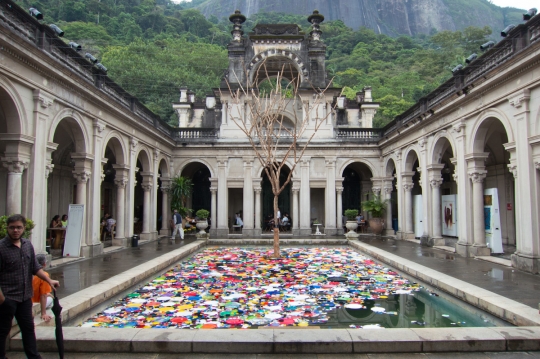
The photos in this post are snapshots from Rio, where I was giving a talk at the Creativity World Biennale...
While I've been giving talks in what seems like just about everywhere, Justin, Marco, Kalle, Maija, and Anna have been more than earning their living by keeping the projects on track.
On the top of our minds right now is Open Kitchen. We've been finalizing the roster of speakers, writing assignments, and briefing speakers. The first item has proven to be a little tricker than we anticipated and so we are finishing things at the last minute. All of the contributors to the programme are people who have a wealth of practical experience and are active entrepreneurs, regulators, restauranteurs, designers, right now. While this is great in terms of the experience they bring to the sessions, it also means that peoples' schedules are harder to contend with. Our neat and clean thematics for each day of the programme have become slightly less crisp in the transition from top-down planning to emergent reality. We made the explicit choice to favor quality of content over ease of scheduling, though, so this is what we get!
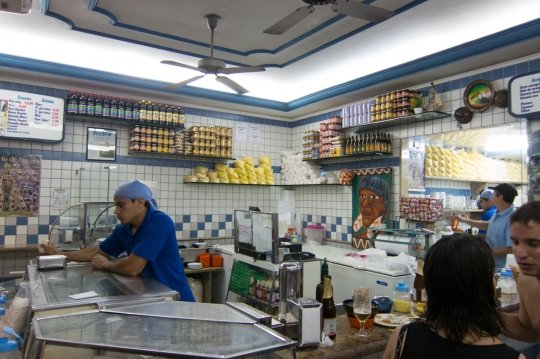
Of course I took the opportunity to check out local street food and other eats. Açai remains my favorite snack in Brazil.
We're also excited to have selected two Aalto University students who will work with the Open Kitchen participants to design their collaborative restaurant. It's going to be a barnstorm—they will have two days to do everything from menus to interiors—but the pair are talented so I think we'll see good things from them.
Marco had a busy day yesterday. He started the morning with an appearance on MTV3'sHuomenta Suomi (Good Morning, Finland) show to discuss the World Design Capital and then spent the day in Finlandia House MC'ing the closing event of the WDC. Lots of familiar faces were in town for that, so I'm especially disappointed to have missed it.
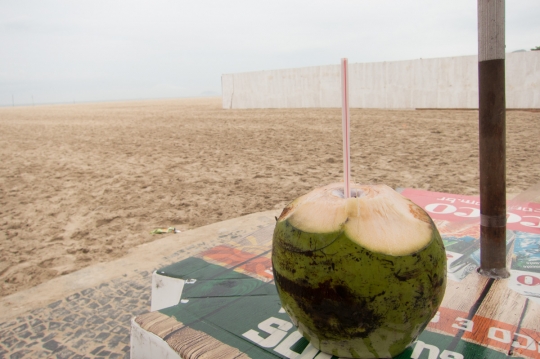
The coconuts were not too bad either.
Maija and Erkki have been in eastern Finland meeting with a town there about the possibility of doing a sort of micro-Brickstarter prototype. I happened to run into Candy Chang, a friend and former neighbor, while I was in Rio de Janeiro, and we were able to share notes. She is part of the team behind Neighborland. Meanwhile, we are pushing ahead with a reflective summary and wrap-up of our research in this area. I'm rather behind on some writing for the site. That's likely to be part of my weekend.
Jaana, our embedded designer in the City of Helsinki Social Services dept, is off to the races with the redesign of the website and access channels for their in-home family care services. We should have something to show there by the end of the year, but no promises just yet. It's about to be pikku juolu (lit. "little christmas") season in Finland and that always seems to stretch timelines.
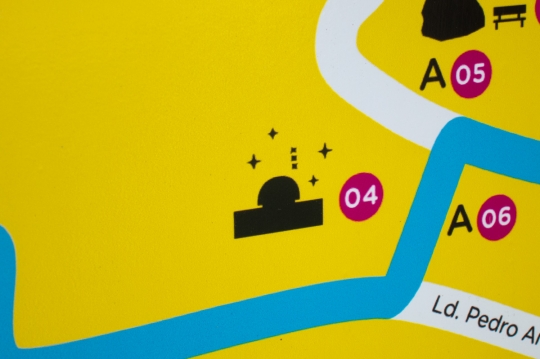
An excellent icon for one of the local observatories.
As a last thought before dutifully stowing my laptop and preparing for landing, I'm grateful to the many people I had the pleasure of meeting across Canada recently thanks to my trip there hosted by Social Innovation Generation. Nate Archer, Cameron Norman, Geraldine Cahill of MaRS, and ISIS at the Sauder School of Business in Vancouver took the time to blog about my various talks there.
And there's the red light and the reliable bing-bong of the landing preparation ritual.
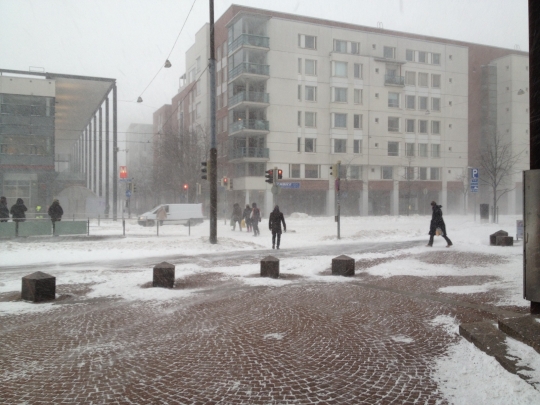
This is the scene from the office, after landing. Quite the contrast.
Jesper Christiansen of MindLab and Laura Bunt of Nesta recently published an excellent paper entitled Innovation in Policy: allowing for creativity, social complexity, and uncertainty in public governance. I enjoyed reading a draft of the paper and acting as a respondent, both through a chain of emails as well as offering some remarks at a small seminar held at MindLab in Copenhagen. For more background on the paper, Laura's blog post is also relevant.

My full remarks are available on the MindLab blog. But to spark your interest, I'll give you a taste that ends with a riddle:
I agree that we are beset by crises, but I’m optimistic enough to expect that humanity will weather them relatively unscathed as individuals, families, and communities. The question is whether our institutions will be as lucky.
I’d like to begin with a riddle. What binds together the following…?
- A pop-up restaurant
- A Private school
- A Riot
- An Email
To find out, hop over to the MindLab blog!
First, some big news. We're sad (but proud and also happy!) to announce that Dan has moved on from Sitra and has taken up a new post as CEO of Fabrica, the communications research center of the Benetton company. He will be back to make a final post on this blog in the nearish future, but currently he's a bit pre-occupied with his new work in Italy. As you might expect!
Second, some less big news. We published four booklets recently. Read more about them here and here.

Publication dummies all lined up
It's only Wednesday so this weeknote is coming early. I'm in the air somewhere halfway across Canada. Actually, just south of a town called Outlook, which is an ironic thing to spot when glancing up from my inbox to scan the inflight map.
Tim Dramin and his excellent team at Social Innovation Generation (SIG) have been hosting me for visit to Toronto these past two days. MaRS has been by nexus during these days and it's a bit like hanging around an alternate reality version of Sitra. We're different in important ways (they incubate and we don't, for instance) but there's a familiar buzz in the air. Before that I was in Montreal with the McConnell Family foundation, and currently I'm on my way to Vancouver where I'll be hosted by Al Etmanski of SIG West.
These days have been (and will continue to be) packed. Canada seems to be mobilizing quite an effort around labs of various sorts: design labs, change labs, social innovation labs. There's an investment in codifying the various types and I'm curious to see how this evolves. Lisa Torjman's paper from earlier this year, entitled Labs: Designing The Future, is a good starting point, as is the Policy Horizons Canada document which was recently published. HDL's appearance in both have provided useful opportunities for us to see ourselves anew through someone else's analysis.
We got roped into the lab discussion in Canada and have since been enjoying an ongoing dialogue about what a lab is and what it does well. But here's a secret: we didn't choose the name "lab," we inherited it.
To be honest, all of us here on the HDL team have felt a bit uncomfortable with the term since we started ramping things up in 2009. Our initial skepticism came from a sinking feeling that "lab" was a bit of a trendy term. On the other hand, there was already momentum behind the name, and something of a legacy. So, as hard as we tried to make up a better name, we weren't able to. We accepted it for what it was and is: just a name. Plus, it performs well as a search term, which is not to be underestimated.
If I remember correctly, the top alternative was Strategic Design Lab. The reason we nixed that option is because it's too generic. It's harder to search for. It gives you nothing to grab onto. Our work, even when we have a global perspective, is rooted in Helsinki. It's an ongoing discussion and an evolving practice that draws from the legacy of Sitra and that of design in Finland and the broader Nordic region.
And almost by accident—or was it subconsciously?—we've arrived at a place where many of our projects are situated within the city. Today more than when we began things, our work is starting to look like Helsinki Design Lab. Speculating on and prototyping future Helsinkis. That's a topic for another day.
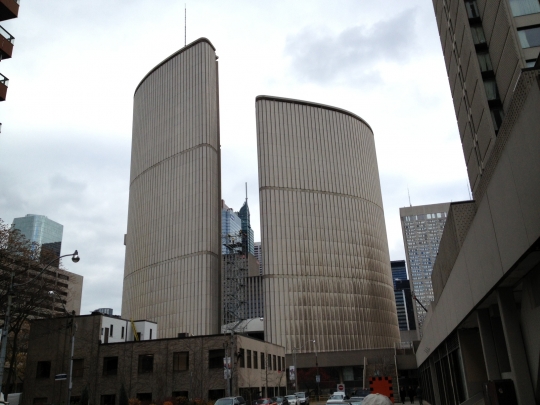
Toronto City hall designed by Finnish architect Viljo Revell
Still, "lab" has been the active word in my trip to Canada and I've been reflecting on how we define ourselves as a lab. If we're to own the fullness of the name Helsinki Design Lab, what does that mean? What is a lab? What is our lab? The notes I wrote on my way to Canada earlier this week:
Lab: platform for coherence and continuity
Lab: conducts experiments to generate evidence that guide further experiments
Lab: should have a portfolio of activity (not just one thing)
Lab: not a process but a practice
Lab: a place (but nothing fancy)
Lab: a core team
Lab: has a set of (consistent) tools
Lab: hosts an evolving conversation
The strength of our lab resides in the fact that we're able to work in an agile or nimble manner. Continuity on a basic level (funding, infrastructure, team, tools) enables us to pursue an evolving portfolio of projects using whatever combination of processes and tools are most appropriate for the specific projects at hand, in the specific moment.
This agnosticism towards tools and processes enables us to be flexible and opportunistic when we need to be—or put another way, when being flexible is the cheaper, faster, or easier pathway to our desired impacts. When we need to pivot, we can pivot. But pivoting is not easy, so the continuity of our shared practice is important. We've literally had to practice this work together to become adept at it. It's a new approach to producing social change, so I think it would be silly to assume that we could get that right without practicing in quite a literal way. One can only read so much music theory before sitting down at the keyboard, as it were.
In practical terms this means that we maintain a basic ability to reallocate our staffing, our budgeting, and our approach to a problem when necessary. This is not easy, but it's critically important. By definition, when doing something truly innovative it's not possible to predict all aspects of the work in advance. With the hindsight of 100 years from now, the belief that such planning and prediction is cheap enough to bake into everything we do will seem like a glitch. Measurement and feedback loops, yes, but we will have to find a way to integrate some degree of fuzziness.
Factories stamp out the same ole widgets, but labs are about developing an understanding for how to do new things. They are places where we expect to see configurations of equipment half deconstructed and reassembled into motley but functional piles. It's not just our desks which are messy at HDL/Sitra Strategic Design Unit, our work is also messy and unpredictable at times. It speeds up and slows down; it goes over budget and sometimes comes in under budget; but every now and then we hit upon something truly effective and that helps us learn about the world.
For a lab, and especially a lab situated within an organization like Sitra that has a financial acumen, the portfolio is the most natural scale of evaluation. Is the sum total of everything the lab is involved in net positive? It's easier for our colleagues in the endowment capital group to check their mixed portfolio of different asset classes and get a sense of whether the numbers are up or down—regardless of asset class, they're all reporting in euros. For our work we're sometimes struggling to make sense of numbers, intuition, and narratives. These make difficult bedfellows as metrics to assess a single portfolio, but it's something that we've developed a skill at through a four year conversation within the team. Good. The next question is how to codify that so that the next group can figure out how to do it in half the time. Eventually we'll all get there.
That's the thing, isn't it? We have 150 years of practice (or more) in predicting and working with financial indicators. It may be extremely important to develop ways to do the same with social indicators, but that doesn't mean we should expect that it will happen faster. We can and should desire that we, as a society, skill up in this area much more rapidly than we did with financial capital, but the likelihood is that we will be struggling with these questions for decades to come.
So I return to the lab as a platform of continuity that hosts an ongoing and evolving discussion around a limited set of issues. One that nurtures knowledge and produces evidence. One that serves the outside world and itself benefits by having feedback loops that enhance the next efforts. The goal of our science labs is not just to produce breakthroughs in their own particular corner of study, but also to become better at science itself.
The practice we're nurturing is strategic design. We're developing a way of designing tangible projects that help us identify and act on systemic change opportunities. We're developing ways to use projects to help us see and then change our cultures of decision-making. We're developing projects that have incremental tangible outcomes so that if they become compromised, canceled, or failed before reaching their final goals that we will still be left with some form of net positive results.
Tomorrow comes to us courtesy of the relentless incrementalism of today, and sometimes (but rarely) we find a beautiful shortcut. If there's one thing a lab does, it's to deliberately search for these shortcuts and then run through them as fast as it can.
The quick update is that the three case studies we've had for a while are now available as print on demand booklets and as revamped PDF downloads. Nestled amongst the flora and minerals of Helsinki, they look like this:
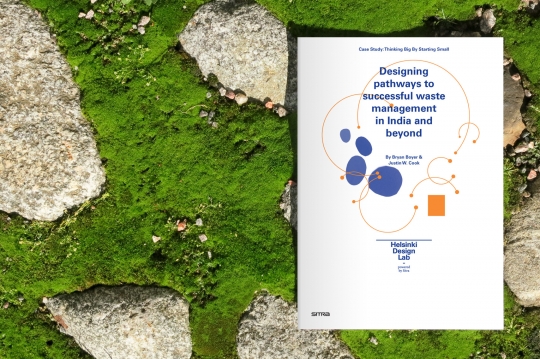
Download Thinking Big by Starting Small as a PDF, order a printed copy, or view online.
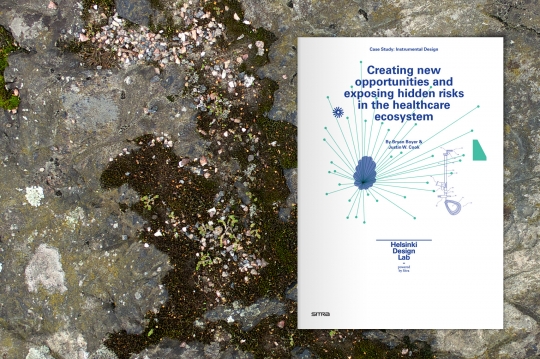
Download Instrumental Design as a PDF, order a printed copy, or view online.
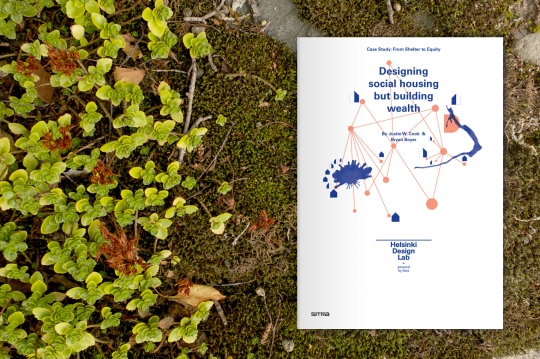
Download From Shelter to Equity as a PDF, order a printed copy, or view online.
The content is 99.8% the same, but we've changed the format. When we started this iteration of HDL we felt the need to create a bit of literature that would describe strategic design as we saw it. At that point, in late 2008 / early 2009 we had not done any Studios, Low2No was not launched yet, and the other projects were not even on the radar. So we needed examples.
The cases became those examples and we felt that it was important for HDL/Sitra to act as an objective voice that could discuss the good, the bad, and the difficult in each of the cases. So we set out to write about design in a somewhat unusual way: the subject was design activity, but we imagined ourselves writing to an audience of policymakers. The task with the cases was to figure out how to demonstrate the value of the strategic design approach. This seems more commonplace now, but there were few people using design and policy in the same sentence in 2008.
An animation depicting the writing process for the first three case studies in early 2009
This led to rather long documents that thoroughly document the work. But at the same time the length of the cases makes them somewhat difficult to approach. They're long, but what if you only have a few minutes to read?
In reformatting them as booklets we've tried to address this in a couple ways. The first of which, and the only new writing in the booklets, is to provide a bullet-point overview right at the beginning. On the left column of the overview you see the story in a few bullets. On the right you see 'points of practice' that are drawn from this.
Borrowing from the design of the case pages on this website, we've started each narrative with a paragraph in large letters. As the table of contents for each one reads, if you're short on time, just read this one page. The first paragraph or two tells the story from end to end. Hopefully if you read this one page you'll be convinced to give the rest of the document a shot.
The body of the text is unchanged. We've adopted a format for these pages that puts the images in the margins as links to a figures section. In all honesty, keeping the full images in a figures section makes the layout work much quicker since we don't have to adjust the flow of the text to the images. With this done in my free time between various other projects, time was an important consideration. If we had more time it would be nice to draft a set of questions that could be used in conjunction with these documents in a teaching environment. Someday.
Redoing these cases was a pretty quick project, but I hope the extra effort was worth it, and that it gives them something of a new life. Or rather, I hope you give them a new life by downloading and reading them.
But now a moment to reflect on one of our miscalculations during the last four years. When we launched this website we thought that there would be plenty of cases out there just waiting to be documented. In early discussions with BERG, who helped us nail down our strategic positioning, we talked (dreamt?) about a regular flow of case studies. At the time we thought there must be tons of people practicing strategic design that we just hadn't met yet. We would take submissions on the site and then publish the best on a yearly basis. Or so we thought.
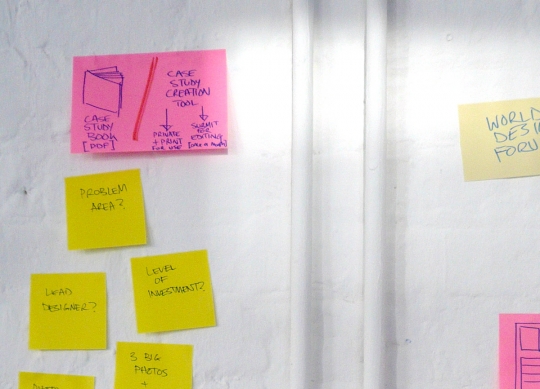
From an early strategy session. In the top left there you can see the idea of an annual case study book.
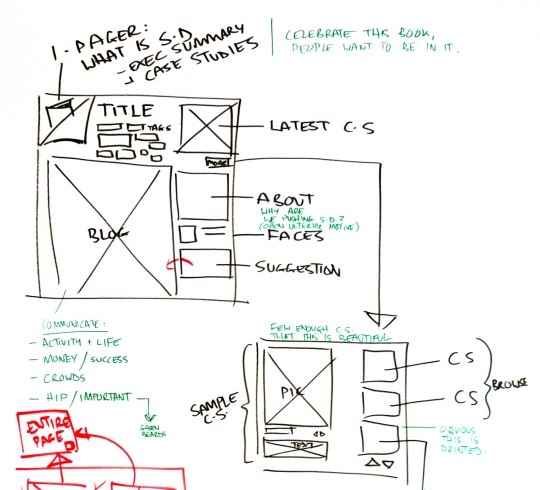
Early website wireframe: "Celebrate this book. People want to be in it."
This was before we set about drafting a long list of cases, querying our network for suggestions, and then doing the research on a short list of possibilities. What we found is that the total number of cases was in the 10s, not the 100s. The pipeline that we imagined was not gushing; it was barely a trickle. This made the cases we did find more precious, but it also meant that some of the assumptions about the total volume of work were incorrect. We were careful to be very specific about what qualified as a strategic design case study, and the result is that very little qualified. I stand by the decisions that we made about narrowing the scope, but it means that we also narrowed the volume.
Unfortunately, we were moving so quickly that this visioning process was going on at the same time as we were building the website and we faced a choice: how to handle case study submissions. On the assumption there would be a steady stream of strategic design cases, we designed an elegant case study submissions process with the help of XOXCO and Rumors Studio, who were the team that built this site.

A screenshot of the submission process (still live) which gets little use.
The case study submission process is a pretty complicated thing to build but the team managed to make it seamless from a user perspective. The work is top notch, but I'm sorry to report that it has been used a total of less than 10 times. 10 times in four years! Admitting this is painful because it means that we spent money and time to automate something that didn't need to be automated because there is not enough volume. Admitting this is painful because it means I made an error of judgement.
It drives home a point made by Joi Ito, one that I refer to regularly these days, so excuse me for being repetitive: it can be more expensive to plan and prepare than it is to develop and test with real users (particularly when considering software). If I had a time machine I would jump back to 2009 and tell younger-me to slap a basic contact form on the submission page and see how it goes. Just deal with the (presumed) onslaught of poorly formatted word documents, mismatched PDFs, and random emails. Putting up with it for just a little bit means that you only invest in building software when you know it's going to return value. If there were avalanches of submissions then it would not only be worth the time and money to make an automated submission process, but we would also have examples of what the submissions look like and so we'd be better informed about how the process should work.
But I don't have a time machine, so instead that leaves us here, with me shamelessly sharing our findings and telling you not to invest money in building a custom process until you've done it manually at least 10-20 times.
I'm not fretting, though. Today we have a better handle on what constitutes a strategic design case study, we have a better network that informs us about projects here and there, and more of this design work is being practiced around the world. That's what matters.
Onwards!
At any given moment we're working on things ranging from helping the city of Helsinki develop new service modalities for child care, to proposing a model for low carbon development, to rethinking the way governments interact with citizens—but one thing that's consistent across every project, regardless of content, is the need to collaborate. Simply put, we do almost nothing alone. Today I'm happy to announce that Sitra has published Creative Collaborations, a practical guide for working together, written by OpenEndedGroup (more on them in a second).
You can download a copy here.
By creative collaborations we mean work that, in the words of the authors:
— Follows no leader: Collaborators interact with each other on an equal basis. They engage in a freewheeling dialogue whose process and outcome remain open-ended until they come to a shared conclusion.
— Aim at invention: Collaborators occupy themselves with exploring diverse, far-flung, and even contradictory ideas, keeping at it for as long as required to alight upon a good and novel solution.
Participating in efforts such as this can be awkward, or even difficult, if one is not used to it. There's a rhythm to working together in this way and it's something that one usually needs to grow into, something that one has to practice.
More often than not we are introducing our collaborators to multidisciplinary work and for that reason we found ourselves wanting to have a guide that we could offer. Something that gives people an idea of what they might expect when being part of a creative collaboration.
To help us with this, we commissioned Marc Downie, Shelley Eshkar, and Paul Kaiser, who together comprise the OpenEndedGroup. They've honed the practice of working with others during decades of multidisciplinary arts projects, collaborating with artists such as Merce Cunningham, Bill T. Jones, and Robert Wilson as well with as with conductors, musicians, lighting designers, architects, scientists, engineers, and scholars.
The OpenEndedGroup drafted a text that proposes five roles (Collaborator, Contributor, Contractor, Curator, Constituents) and then 19 rules of thumb for collaborators. The result is a slim booklet that reads easily and quickly. I would have loved to have had this before the Studios we did in 2010 and 2011, for instance. It will be a valuable resource for future studios and other projects.
Sharing this today is part of our continued effort to maintain a legible practice. That is, to invest part of our time in describing how we do our work—how we practice design—in hopes that it will help us learn from our peers.
And because we believe in making everything we do public, we're offering the booklet for free download under a Creative Commons license. If you're the sort who likes to read on paper, you can also get a copy via print on demand service Lulu.com.
Doing the graphic design for the the booklet was one of my summer projects, and itself a collaboration with lots of back and forth between OpenEndedGroup and us as we collectively tweaked the format and the content.
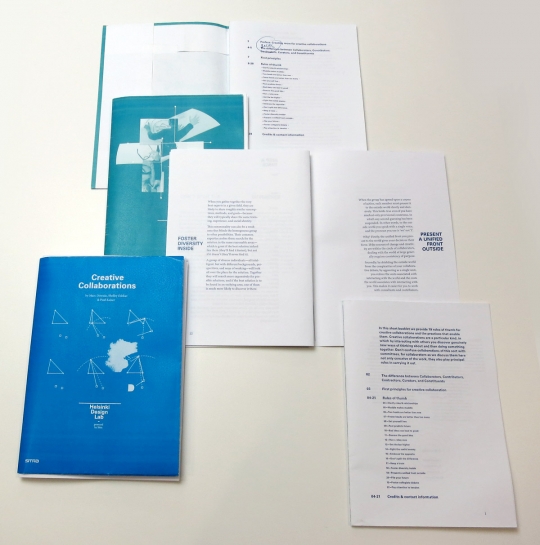
A pile of layout dummies testing different covers and interiors.
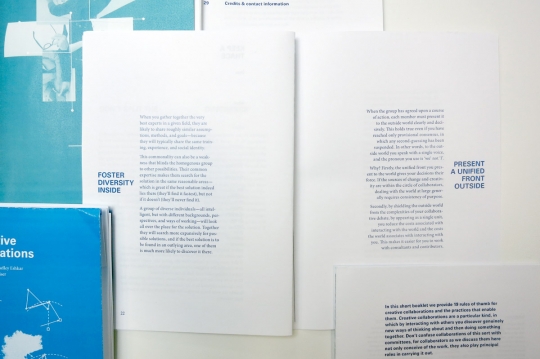
For a brief phase the booklet featured narrative typography, which worked OK on a spread like this, but was difficult to resolve on pages with content that did not lend itself directly to typographic representations.
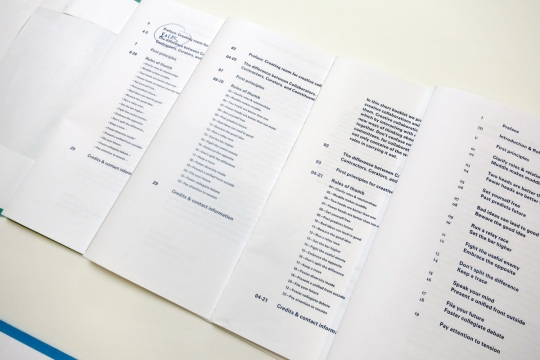
Who knew a table of contents could go through so many revisions?
Many thanks to Marc, Shelley, and Paul for their clear and concise writing. Download a copy and see if you enjoy it as much as we did.
I'll end this post with a request. On our Design Ethnography Field Guide download page we have listed alternative sources in case people want to see similar resources. If you have other resources which are useful guides for collaborative work please leave a message in the comments or let us know via @HDL2010 on Twitter so we can build a pool of resources around this topic as well.
Gray. Dark. From the Sitra tower one sees a vista of offices, homes, and shops glowing warmly beneath a thick cloud cover. The idle booms of a coal ship docked not too far away shine orange under sodium-vapour lights. At ground level metal surfaces reflects the red of brake lights, meaning people are on the way home. Marking the horizon, a strip of faint and fuzzy peach just visible beneath layers of dirty, gauzy, clouds.
More travel these past two weeks (not unlike one year ago). In week 188 Marco was at Dutch Design Week and then at a session at the Danish Parliament (which we all enjoyed hearing about because we are hopeless Borgen fans). He's just back from Moscow, where he was part of a session on the development of Skolkovo. Last week I was in Portugal to give a talk at Cidadania 2.0 (Citizenship 2.0) and then took a day off in Barcelona before coming back north. While there it was nice to catch up with Martin Lorenz and Lupi Asensio of TwoPoints, who did the visual identity for HDL as well as the design of In Studio.
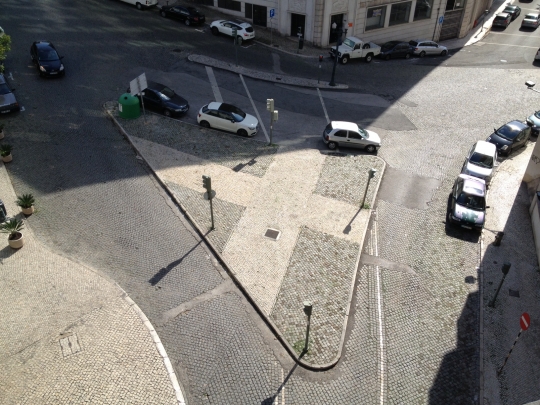
An almost-Finnish-flag literally on the streets of Lisbon
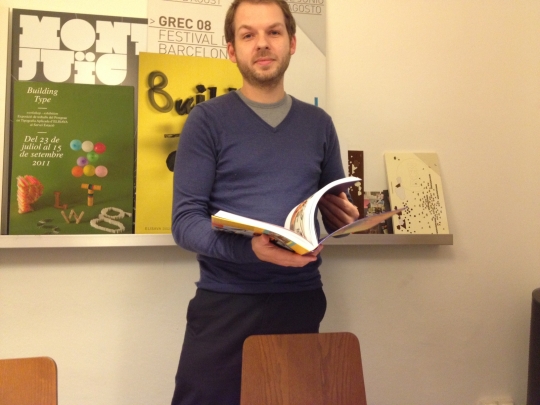
Martin explaining that "there's no ugly anymore, just boring."
In Lisbon Frederico Duarte gave me a tour of the city (and its food). A couple months ago Frederico wrote about Helsinki Street Eats in a profile of the city that he did for Fugas Publico, so it was nice to be able to meet in person. His own recent publication on the cakes of Portugal is an enticing read. I'm quite glad that I got a copy of it at the end of my trip or I might have come back a few kilos heavier.
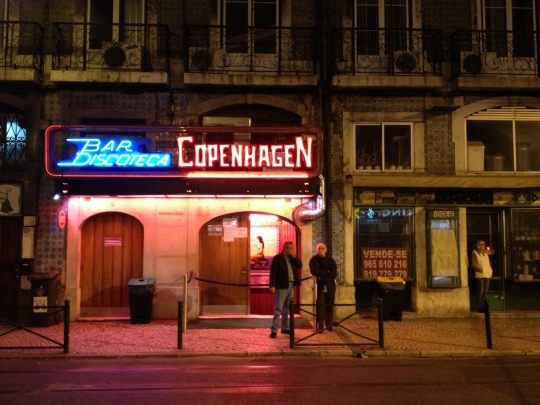
Lisbon has a nordic nightlife corner with clubs named Oslo, Copenhagen, and Viking. Who's going to start Helsinki?
On Monday we announced the participants for Open Kitchen. Out of 53 applicants we were able to make room for 13. The response was overwhelming and most of the people who applied did so by video (as we requested). The enthusiasm and eloquence in the videos is something that we want to share with you too, so Kalle is hard at work editing them into a single clip. Once we do that and get permission from everyone we'll post it here and on the Open Kitchen Facebook page.
The diversity of the applicants is what excited me most. From 19 to 40+, Finland to Brazil, burgers to ancient preservation techniques, we had a bit of everything it seems. We tried our best to capture that in the final group:
- Archibong wants to fuse African and western food
- Saila wants to give shape to a new kind of ice cream
- Mark dreams of smoked meats (and some bacon sandwiches, we hope)
- Anni believes in stylish an uncomplicated lunches
- Fatim's social kitchen will be an anchor point for newcomers to Finland
- Alba will bring the warmth of Mediterranean dining to Helsinki
- David is investigating ancient preservation techniques
- Elaine is going to show us how Brazilians do effortless nose-to-tail dining
- Jérôme tells us that bread is about friendship
- Jonatan & Nicklas are pure energy and enthusiasm
- Nguyen thinks Vietnamese food in Finland can be better
- Veronica believes in food, flowers, and friendship
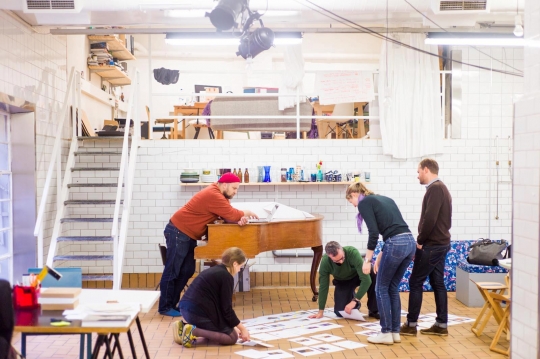
Jurying the Open Kitchen applications was quite a task.
Next steps with Open Kitchen are to launch a similar call for two design students to help the team design and build their prototype restaurant. If this sounds interesting to you (and you're based in Helsinki) please follow the Facebook page for an update next week.
Brickstarter needs more attention than we're giving it at the moment. Maija, Dan, and I have a lot of writing to finish up. We sketched that out on the whiteboard last week, but unfortunately there's is not yet a device to turn marker scribbles into coherent, articulate prose. We are currently exploring the possibility of doing a MVP (minimum viable product) version of Brickstarter with a municipality that's east of Helsinki. More details when they're stable.
A trickle of HDL 2012 feedback has been coming in, including corrections and amendments to the cases we wrote. Next week we will be making some decisions about whether or not we put the cases together into a publication, and if so how. That's part of a larger discussion about what the future holds for HDL.
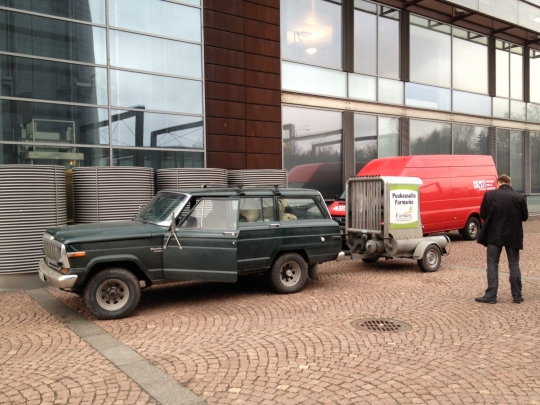
A wood-fired car visited Sitra. It's gasifies wood chips!
Which leaves us with a long overdue project, a booklet that we comissioned the OpenEndedGroup to write. I spent the week checking all the final boxes so that this can go to press and get pushed live on the website for downloads. That'll happen early next week, so all I can do for now is tease you with these images. It's a plain spoken booklet about how to collaborate on creative projects. It's the kind of thing we might encourage people to read before joining us for a studio, for instance.
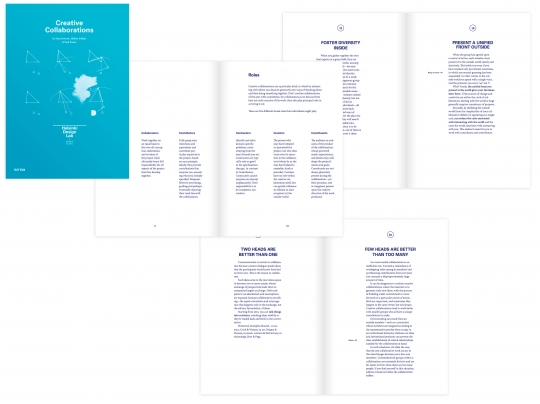
Creative Collaborations by Marc Downie, Shelley Eshkar & Paul Kaiser. Publication forthcoming!
Before I end this weeknote and begin my weekend, two announcements for November. Social Innovation Generation (SIG) is hosting me for a tour of, well, most of Canada. In Toronto I'll be giving a public talk that you can sign up for here at 18:00 on the 12th. We've had an ongoing discussion with SIG and a few other groups in Canada, as well as receiving more than a couple visitors here at HQ, so I'm looking forward to seeing things on the other end of this cross-atlantic friendship.
After Canada I will be heading to Rio de Janeiro to give a talk at the Creativity World Biennale. And then I will sleep for a week straight.
It would be excellent to meet readers of this blog at these events. If you're attending please say hello.
To supplement what Dan wrote about the proceedings of HDL Global 2012, I wanted to share some of the photos from the event as well. Thanks to Johannes Romppanen for all of these!
And more on Flickr.
We're now working on the cases from HDL 2012 to get them into a format that can be shared more widely. No promises on the timeline for that, but perhaps early-mid next year.
It's only tuesday and already the supply of stroopwafels in the office is dangerously low. As is customary on our team, on a trip to the Netherlands one is obligated to return with wafels. I was in Eindhoven at the end of last week and I did my duty, but apparently I miscalculated the quantities. More about the trip in a moment, but first we need to get to something rather incredible.

Open Kitchen also has a new logo courtesy of Sanna Mander!
Applications for Open Kitchen closed last monday and we got roughly 50 applications and the lot of them are impressive! We asked people to make short videos that describe themselves, their experience, and how their food concept will make make Helsinki a better place. The applications included people who excited about cakes, tapas, pho, flat whites & avocado toast, flower ice cream sculptures, traditional food preservation techniques, burgers, sourdough breads, and someone offereing a conceptual menu that begins with a starter of "loneliness" and continues with an entrée of "empathy". So in other words, this is all fantastic.
What we heard from the application videos is that Open Kitchen is exactly the sort of thing people have been waiting for. Now begins the difficult task of winnowing it down to a batch of ~12 people who we have room for in the programme. Tomorrow is the day for that and we'll be balancing multiple criteria:
- Sustainability: is there a concern for local and sustainable aspects of preparation, logistics, consumption, recycling?
- Diversity: is there a new kind of cuisine, a new experience, or a new perspective?
- Everyday: is the applicant interested in basic food experiences (not fine dining) that improve everyday life?
- Social: does the applicant see food as a social object that creates a bridge between diverse publics?
- Drive: does the individual show drive, determination, spark, verve, commitment?
The final selection will be posted next week. We are also hoping to post some examples of the applications, but first we need to get permission from the applicants.
To get the word about Open Kitchen we did an experiment with Facebook ads. We spent a total of €350.62 running two parallel ad campaigns for about 3 weeks. These were targetted to all people living in Finland age 17 or older (about 1,969,280 total Facebook users). To put this into perspective, it would cost €430 to have a banner ad on the popular Nyt.fi website or about €3,000 to have a small ad in the print version.
The response was rather rapid and we saw significant growth of the likes on the Open Kitchen Facebook page, an increased number of questions, and people sharing our posts. What we don't know yet is how many of the applicants found out about OK on Facebook versus other channels. Kalle will be following up with everyone to inquire about that so we have a better picture of how useful this method of advertising was. Here's a view of the stats for the lifetime of the campaign:
Dan had a good meeting with Jaana, who is our Design Exchange person working at the Helsinki Department of Social Services. He, Marco, and myself will swarm with Jaana on a quick project that she's starting now. The gist of it is that there will be an experiment in making preventative help more accessible, ranging from basic parenting advice up to complicated social difficulties. We think this means a combination of new online and offline possibilities to get access to help before there's a problem, but we're not exactly sure yet what shape this will take. It's Jaana's project, but we're here to help.
Down in Istanbul our installation of Brickstarter is now open to the public as part of the Istanbul Design Biennial. If you're not able to see it in the flesh, you can check out the boards we presented here and a bit of backstory here. This opportunity came up at the last minute and it was quite a lift to get the exhibition squared away while also finishing up everything for HDL 2012, but in the end I'm quite happy with how things came out. As an added bonus, the boards for the exhibition are useful as slides to be used in Keynote (thanks to the magical Magic Move transition).
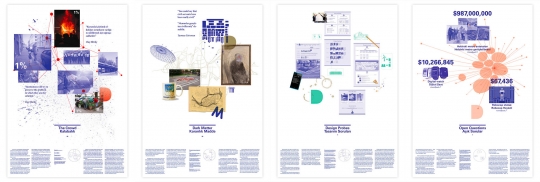
The Crowd, Dark Matter, Design Probes, Open Questions
After HDL Global 2012 concluded Marco and I both got on planes for Italy. He took a well-earned week off with his family. I was headed to European Center Living Technology to share our perspective on strategic design as part of a meeting about Envisioning a Socially Sustainable Future.
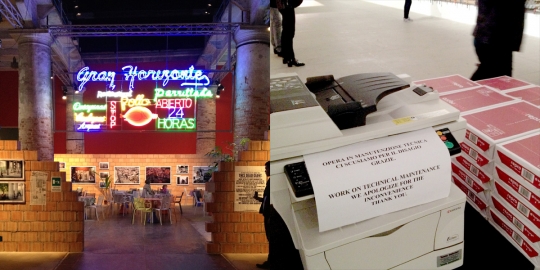
While in Venice I had a morning to visit the Architecture Biennale, which was useful to see in comparison to our own work in Istanbul. We've installed a "grumpy printer" and it appears that FAT are of a similar mind with their contribution in the Biennale (one of the highlights).
From there it was on to Ljubljana to be part of their Month of Design with a delegation of other colleagues from Finland.
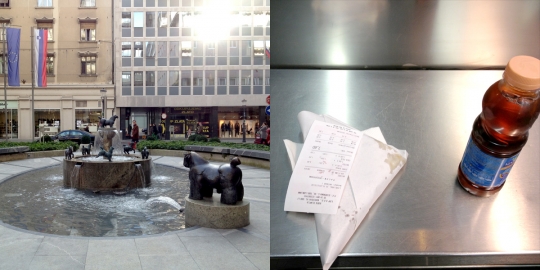
Out and about in Ljubljana. A local friend took me on a street food tour, of which the Burek was the highlight.
And the week ended in Eindhoven where I gave a talk at the World Design Forum and then loaded my suitcase with stroopwafels. Doug Belshaw's thoughts on that event are worth a quick read. Hearing about Doug's work on the Mozilla Open Badges project was one of the highlights for me, as was getting a chance to catch up with John Thackara who moderated the day with aplomb. The organizers have also posted a summary, which is impressively quick considering our HDL 2012 event happened more than a week ago and we're still ruminating.
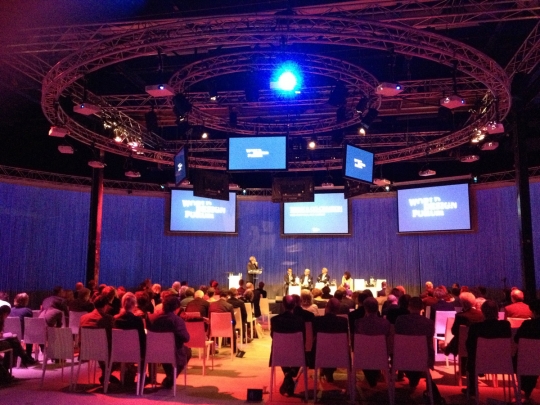
The World Design Forum featured an impressive number of projectors. So many that it kept distracting me from the discussion.
Marco is in Eindhoven now and Copenhagen later this week for Creative Summit (PDF link), Justin's in Boston, Dan's holding down the fort, and I'll be in Portugal for Cidadania 2.0 (Citizenship 2.0). Between travels we're continuing to process HDL 2012 so that we can post more reflections here, picking up where Dan left off last week.
Goodbye, Week 187, you were good to us, but now we must move on.
I'm procrastinating. Sitting next to me is a pile of paper covered in red scribbles. Those scribbles need to get into my computer and fight with some pixels. What comes out the other end will be a series of six case studies crunched down into a digestible format. Standing between us and the weekend are 9000 words. It's not clear yet who's going to win this battle.
The team are scattered, off doing various things, and Maija and I are in the HQ tending to the never-ending HDL logistics for next week. Wooden boat? Reserved. Hotels? Confirmed. Having just done a tasting, I can tell you that the reindeer we'll be having for dinner next week is delicious, in case you were wondering.
Marco spent a good chunk of the week interviewing candidates for two more Design Exchange Programme placements. Once they're selected and hired in we'll have a total of four embedded designers.
This is what I keep thinking about:
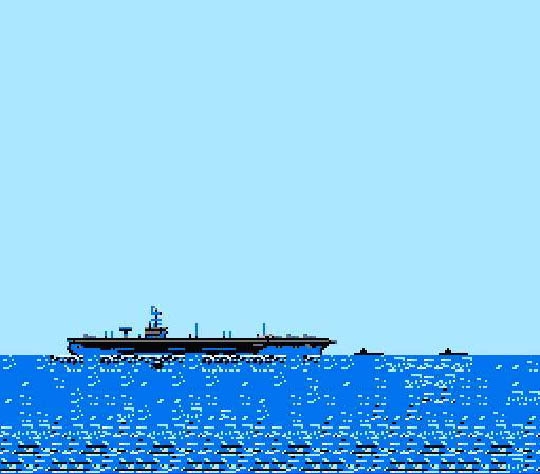
The hardest part of the video game Top Gun was landing your plane on the aircraft carrier. Get the carrier in your sights, modulate the throttle, adjust yaw, avoid roll, and land smoothly on the deck. "Stay on target," as they say.
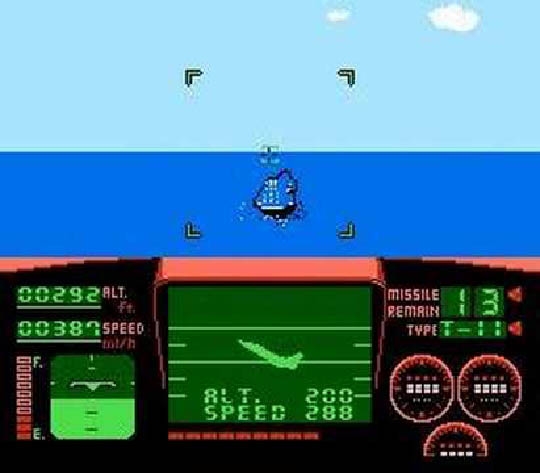
Alongside the preparations for HDL 2012 next week, we've just presentation boards to Istanbul for the Design Biennial there which will feature Brickstarter. Now we know now to say "Dark Matter" in Turkish.
The last piece of that project is an application which will control a laser printer that will be zipping off letters to the 'Public Works Department' on regular intervals. Testing is coming along OK but we still have some bugs to squash.
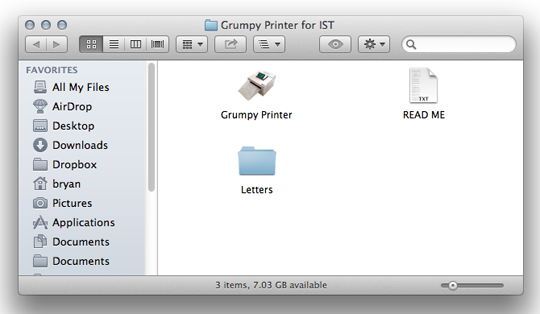
Next week Helsinki will host a gathering of the Délice Network of "good food cities," so we took the opportunity to revamp Helsinki Street Eats to include information about Open Kitchen. We still need to find more time to do a proper update, but for now this is better than nothing. This edition features a new cover as well. Why not. You have 10 more days to apply!
This week was beyond. We're trying to wrap up our Brickstarter installation for the Istanbul Design Biennial, finish case studies of the six projects we learned about this summer, promote Open Kitchen (14 days left to apply!), put together an event with guests from 7 countries on 3 continents, and take care of a few things in between.
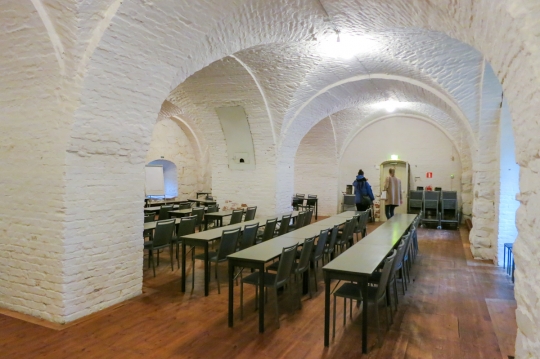
Double checking HDL 2012 logistical details. How's the heat in here? Any extra lighting? Where do coats go? Can we remove these tables?
Marco was at the World Alliance for Low Carbon Cities meeting to give a talk on Tuesday. The same day I was at MindLab in Copenhagen, sitting on a panel organized to respond to and discuss an excellent paper co-authored by Jesper Christiansen and Laura Bunt of Nesta. We'll post a link to the paper once it is published. Later in the week Dan was off to Rotterdam to moderate at panel at the New Towns | New Territories event. Justin held down the fort in the Boston (home) office. Maija and Kalle spent more time than usual at Sitra HQ on the phones, evidence of the fact that these days we're putting things into place.
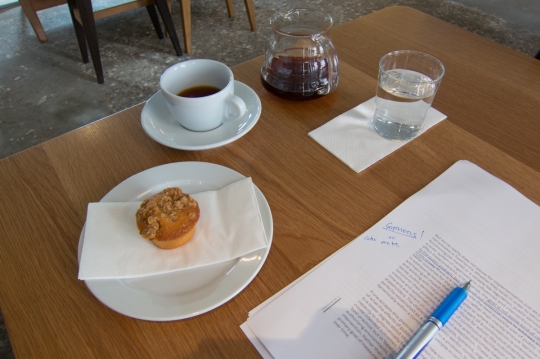
Hurried writing at one of Copenhagen's nicer cafes the morning of the Mindlab session

A quick panorama from the session at MindLab
And since I'm writing this weeknote, I get to abuse my power and show you what I did this weekend. Although I spent a good bit of it working on the case studies, I couldn't pass up the opportunity to go mushroom hunting (!) with some friends. Glad that I did, too, because the forest is in a beautiful way at the moment.
Oh, a first for us! A two-and-a-half-weeknote.
The most recent round of recruiting for our Design Exchange Programme has closed. We had 46 applications for the Environment Ministry post and 47 for the Ministry of Employment and the Economy. Excellent! Marco and the rest of the hiring comittee are hard at work sorting through those now.
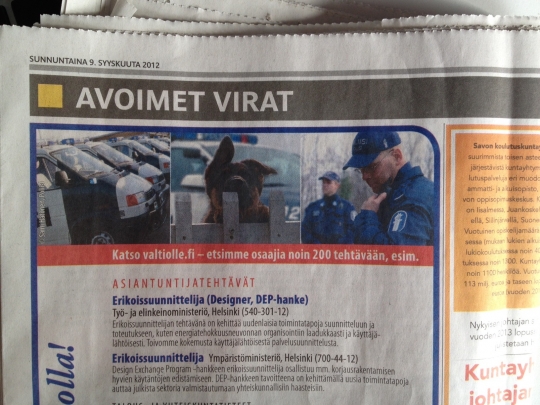
Our DEP positioned advertised in the Helsingin Sanomat... next to the police!
Rory Hyde came to town for a book launch of Future Practice, which includes a forward by Dan and an interview with me.
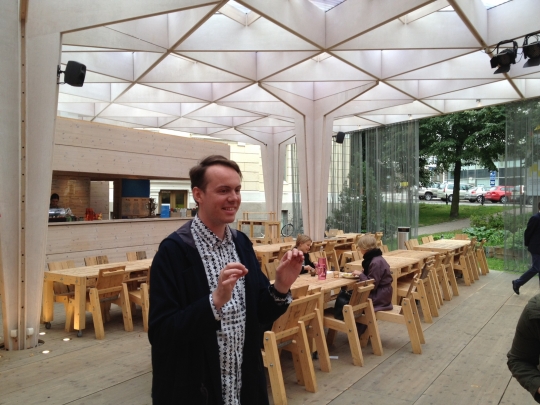
I think he's measuring the gap between today's practice and Future Practice.
We're working on an exhibition of the Brickstarter research project for the Istanbul Design Biennial. It involves things like creating a coffe-stained municipal mug, doing drawings, and writing some simple software.
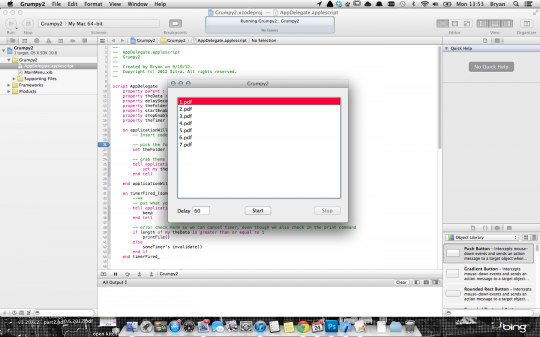
For a fun evening, teach yourself Applescript Objective-C. This will power our "Grumpy Printer".
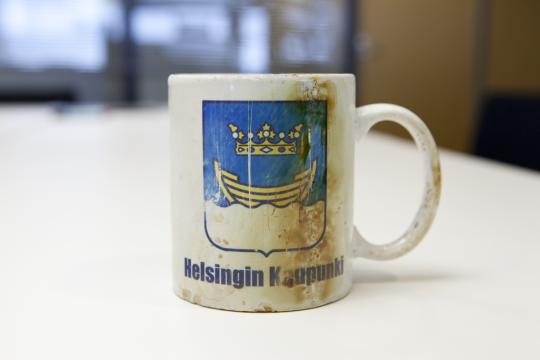
"What font does a municipality use," Maija asks? "Impact!!!" we reply.
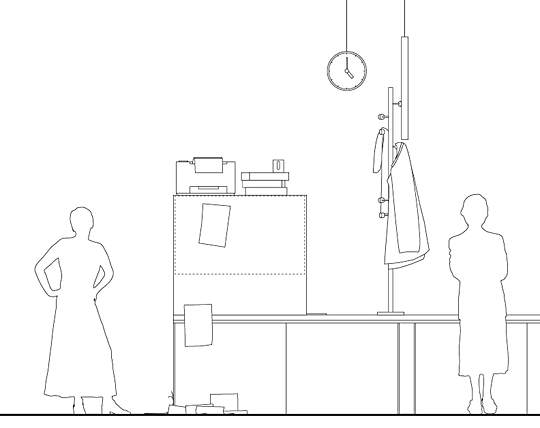
Friend-of-HDL Tuomas Toivonen's song U=Utopia (which was inspired by and namechecks Low2no) was recently covered on episode 16 of Euro crime drama The Spiral.

"I know you're angry, I'm angry too" she sings after Tuomas' lyrics
This is funny:
And this is sad:

Baana skate sculpture surrounded by a moat that the city dug in response to citizen complaints about noises
Remember the Baana project, mentioned here previously? At one end of this sunken recreational pathway there's a sculpture in the shape of the word "Helsinki" extruded up out of concrete.
Last week a visitor would have found it in the state of the image above, featuring a 'moat' cut through the asphalt all around it. Why? To prevent skating. Originally it looked more like this. It was designed for skating, by the way.
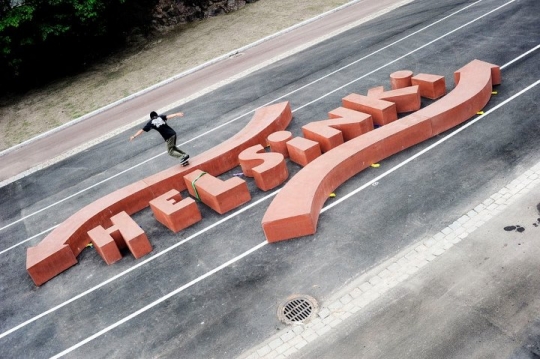
Baana skate sculpture as it originally appeared (image borrowed from Yksivaihde
After an unspecified number of complaints from nearby residents, the skating was deemed inappropriate and the city, as Dan puts rather eloquently, "vandalised their own project" to prevent people from skating. The part that pushes it into full absurdity is when the city's own safety regulations then force it to put orange cones up to mark the moat as a potentially dangerous change of ground surface.
Seemingly before the buzz of the planned 'moat' had even made it around town, the trench was already dug. A high point of city efficiency, to be sure, but not everyone was happy. The entire Baana project had gone through years of development with ample opportunity to comment or complain, as per standard procedures. So why were a few voices able to determine the fate of this city ammenity and have their voices translated into action so quickly, so unilaterally?
Then something doubly surprising happened: the city reacted quickly again, changing tack a second time and announcing that they would re-pave the moat. This restored Baana to its original, skateable condition, but leaves a visible and material scar of the non-debate.
On one hand this is a positive story about an agile city who was able to respond quickly, but on the other hand it's an allegory for the problems to come if we do not have more considered tools to help us negotiate these kinds of questions in the shared spaces of our cities.
Is this much agility always a good thing?
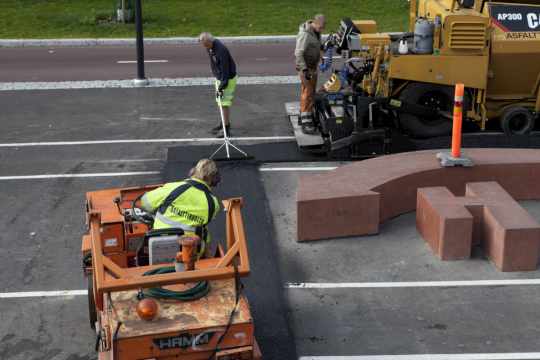
We were lucky to be walking by just as the Baana skate sculpture's moat was being filled in
On the 14th floor of the Sitra tower the view is gray through and through. A fog has set in, obscuring the horizon and veiling not-so-distant Espoo. Autumn has come to rest in Helsinki and we're welcoming the season for its crispness.
This end of the year is a time for being shipshape, and last week that meant launching Open Kitchen. Here's what that's about:
We won't teach you to cook. We teach you the business of food.
Open Kitchen is a programme that demystifies the business of food by creating a forum for you to learn from the city's experienced culinary business people who've been there and done that, and then working with your peers to build and run a prototype restaurant for a week.
Or you can watch Antto, one of Helsinki's most accomplished chefs and restauranteurs, explain it. We're very happy to be working with him, and a slate of other fine people to be announced in the near future. Needless to say, if the idea of learning from Antto and others is appealing to you, and you're located in Helsinki, please apply! You have till October 3rd.
For more on the development of Open Kitchen you can read about how we pivoted from our original idea of establishing a sustianable Grilli towards the current implementation as a sort of dark matter academy.
Maija is busy with Brickstarter, still posting a seemingly endless quantity of fact cards, whilst also working on a set of service journey mappings for self-initiated urbanism. At the macro level, Dan and I are working on the longer term future of the project by refining the scenarios I mentioned last time. That makes it sound more coherent that it is, really. There's a lot of scribbling on paper, sometimes on a whiteboard. More lines than words often.
We spent the first half of last week at MindLab in Copenhagen with Runa, Niels, and Christian, as well as Tom Loosemore and Russell Davies from Government Digital Services, part of the UK Cabinet Office. This was the third and final HDL 2012 case study pairing and it was—like the previous two—a brain-smacking experience. Lots to take in, lots to process. Our challenge is going to be choosing what to focus on with such a wealth of craft knowledge generously shared by MindLab, GDS, and the other case partners.
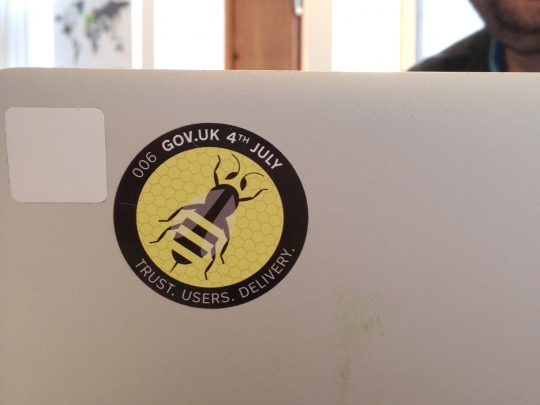
"Mission badges" from GDS. A nice touch of material culture inside their org.
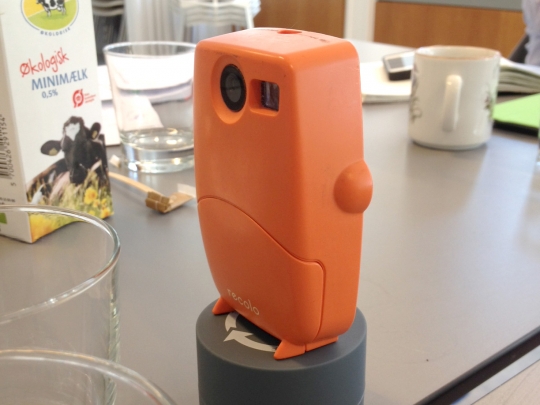
Russell brought a time lapse camera to the meeting.
As with the previous sessions, we looked at one project from each team and left ourselves with a rather wide open agenda so that there would be plenty of room to follow the conversation as it goes. Dan has started collecting his notes from that session. I'll do the same shortly and then we'll have a brainmelt with Marco and Justin to collate the brightest spots from all six projects we've learned about.
Our first pass is via language. What are the words that people use to describe their work? What are the terms that they use, and the meaning they imbue those terms with? This is less of an arbitrary choice than it may seem: one of the threads of consistency that bind the six projects we looked at is that they're all driven by hyper-communicators. People who just really know how to explain things, to share them, and to make them real for others.
HDL 2012 is beginning to consume my calendar, and increasingly eating into others' as well. Maija, Marco, and I spent an afternoon checking logistical details. All is well there, though some items remain outstanding.
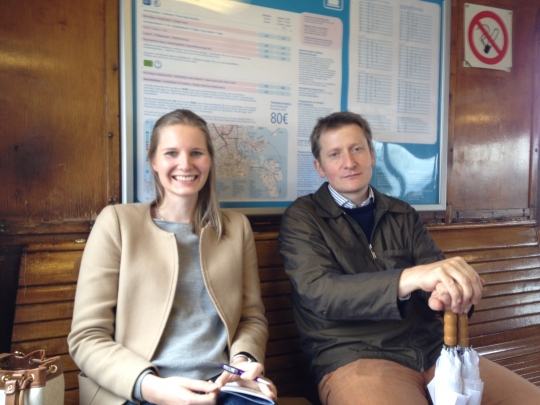
On the boat to scout out locations

Are you the right place for us to have HDL 2012?
The Design Exchange Programme is growing a bit. Jaana Hyvärinen has joined the City of Helsinki Social Services department, where she will be helping build a culture of service design. Sara has a new blog post describing her busy autumn. We should have two more posts open shortly. As ever, we'll post here and on Inside Job when they're live.
Marco has written a blog post on the Low2No site explaining how that project has changed tack a bit. Worth a read if you've been following our work on that one.
And just now the infinite gray outside has broken, giving the Baltic back to us in shades of dirty cobalt. Welcome to Monday.
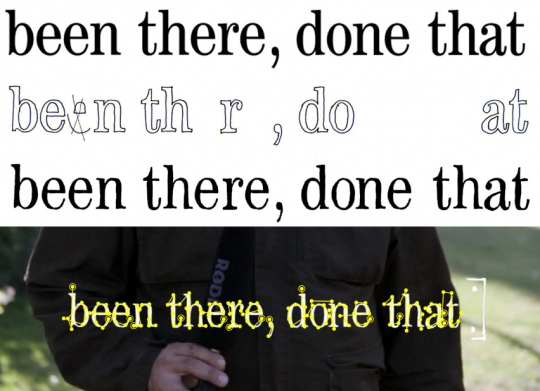
Some scraps from the production process for the Open Kitchen video, included for no other reason than they look nice. Starting from the top: digital text, hand traced text, cloned to fill out the words, and then being animated to write itself onto the screen.
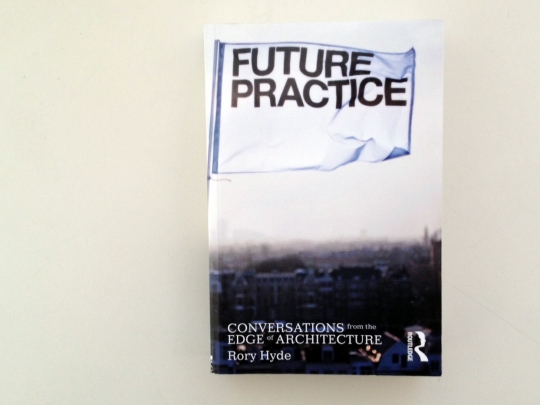
Rory Hyde has written a book about future trajectories for architecture and design practice. Dan wrote the forward and I'm one of the subjects, so we're happy to have Rory in town for a book launch/talk at the Paviljonki tomorrow, Tuesday the 11th at noon.
Last week we finally went live with Open Kitchen. I'll let Antto explain it briefly and if you want more detail you should check the site; this post will focus more on how we ended up with Open Kitchen as a project.
Readers of this blog will know that we like our food, but the motivations for this project go well beyond the desire to get a decent falafel, banh mi, or reindeer sausage in Helsinki. We engage food because we're interested in broadening sustainable consumer choices and fostering social diversity within Finland. Food is a good way to address these topics because it's the original social object. It's a familiar, tangible, and inescapable thing that's deeply tangled in individual preference, shared culture, and dark matter. This is a familiar story, so I wont belabor it. Instead, I'd like to share some of the backstory to the project and use it as an example of the pivot—a play that we've been adapting from the world of startups into our public sector practice.
To plan is to change your business, to pivot is to let your business change you. Despite best efforts to analyze and plan, the world does not always play out according to the script we write for it. In these situations, where you find yourself standing before unexpected opportunity or pitfalls, to pivot is to change the means that you're using to achieve the ends you desire. After a pivot you're headed in a new direction, but still rooted in the same first principles.
One year ago, when we began working on what has now become Open Kitchen, the concept looked like this:
Belly First Sustainability (Food, Public Debate, Business) — Concept Note
We want to accelerate the development of the sustainable food industry and culture in Finland by incubating the Low2No service partnership in anticipation of 2013. The aim is to sell sustainability, one bite at a time.
This is accomplished by building a Sustainable Grilli in Helsinki during the WDC2012 to create an accessible and first-hand entry point to public debate about sustainable lifestyles in Finland. The project is executed in three components: a competition, a temporary food cart business, and an events programme (in Helsinki and other cities) concurrent with the business.
In this draft (from September 15, 2011) you can see that the emphasis is split between providing a platform to prototype part of Low2No and larger systemic change goals around sustainable food. The means we had settled on to achieve this goal was to create and operate a sustainable grilli kioski for the summer.
Between the first conversations Justin and I had about 'belly first sustainability' and writing this concept note, two important things happened: the Camionette and Ravintolapäivä. Both of these unexpected events changed the context of food and food culture in Helsinki, and more importantly they provided tangible evidence of a new group of self-starters. Both involved demonstrations of what that new culture looks like, how it tastes, and how it changes the experience of the city in ways beyond just the foods on offer.
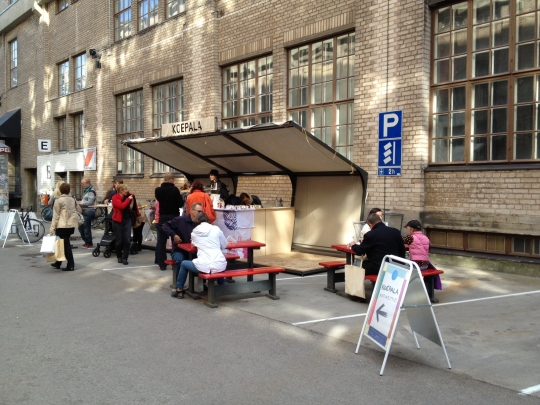
This is a snap of Koepala, a popup during Helsinki Design Week. New food-related concepts are popping up all the time now. Open Kitchen is designed to help them take root.
Both also highlighted problems in public sector decision making. The silos of our regulatory context were not set up to handle initiatives that came in the 'shape' of a food truck or a create-you-own-restaurant festival. The result was some rather public shaming of various public bodies through traditional and social media when those institutions did their normal, conservative thing. To their credit these same organizations responded quickly and positively, but not very coherently.
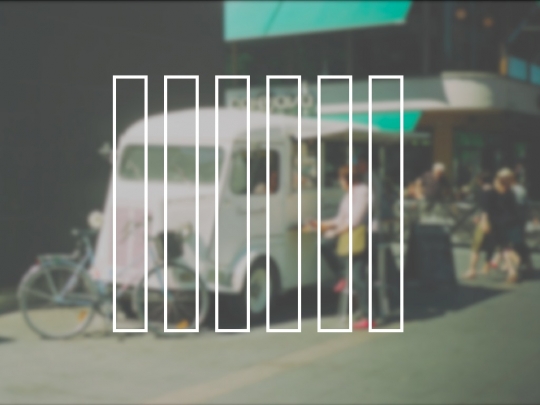
The "shape" of the city's organization doesn't match the interests and experiments of the citizens—here the Camionette. So when something like a food cart first comes along as a question, public bodies can be caught off guard.
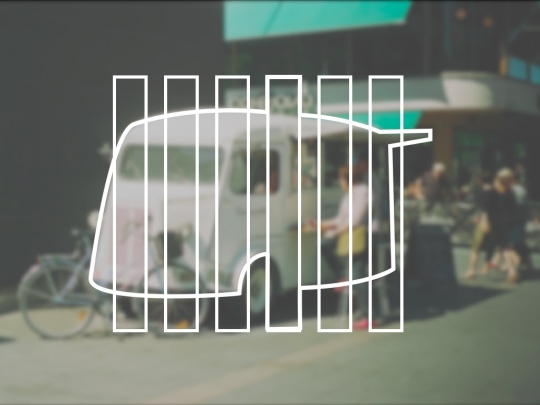
It literally doesn't fit into the silos that the city is organized around.
As we were working the concept note through various parts of the internal machinery of Sitra we were gleefully watching these changes happening on the street. And then something funny happened: we realized that we were developing a project for a world that didn't exist anymore. By the autumn of 2011 Helsinki didn't need a demonstration that sustainable street food was viable. That had been done already by entrepreneurs like Tio Tikka and activists like Olli Sirén.
Yet despite the positive blips that we observed, it remained difficult to get started in sustainable food in Helsinki. There was (and still is) a gap between the effervescent vitality of Restaurant Day and the day after restaurant day, when all of that surplus energy, excitement, and talent subsides back into previous routines. The ladder of innovation is missing some rungs, you might say. Restaurant day is a great way to test out an idea, but for those few who want to go further, where next? What steps exist between a pop-up and taking out a lease on 200 square meters of restaurant real estate?
These missing rungs of the ladder became our focus. We pivoted from a sustainable grilli demonstrating a new food culture, to a dark matter academy that could illuminate the tacit knowledge of sustainable food pioneers in Finland. We want to make it easier to create lasting, thriving sustainable food businesses in Finland. Open Kitchen relies on people who've "been there, done that" to share their knowledge and experience with others.
While this was unfolding we were writing the story, quite literally, in the form of a print-on-demand book. The research that went into the book and early development of the concept led us to meeting people all over the city, from restauranteurs to regulators to politicians, and everyone in between. We wrote it because that was an easy way to send us careening into the thick of things. Rather than sit in Sitra HQ and try to abstractly reason a view of the world, we got out there and started asking people how their corner of it works—or doesn't. Consistent across these meetings was a feeling that there's a good bit of knowledge and experience in the city, but it remains caught in pools—dark pools—within isolated communities.
Amidst our first proper blizzard of the 2011-2012 winter, Dan and I paid a visit to Ville Relander, who heads up Food Strategy for the City of Helsinki, and Elina Forss of Marrot Oy at the newly opened offices of Tukkutori. As we explained our interest in food the conversation fell quickly into a productive rhythm. Marrot, with the support of Ville and others, had been developing Kellohalli as a food culture hub for the city. It was to feature a strong programme of events, a library, and other activities. As strong as the plan was, it still pointed to the missing rungs of the ladder: once people get excited about food, what next? How do you go from enthusiast to entrepreneur?
The idea of the dark matter academy that we had been simmering (sorry!) was suddenly congruent with an opportunity right in front of us, with real names and availability and interest. That was that. In Marrot we had found partners who were already well positioned to help us develop and execute the concept of the dark matter academy for sustainable food. The pivot happened immediately, almost without a thought, because in fact the thinking had already been done and we merely catching up to the full implications of our intentions.
Pivoting can be difficult to accept, especially inside an organization that is used to a linear sequence from scoping to planning to execution to measurement. One of the ways that we try to deal with this is to focus on establishing the first principles of a project early on, revisit them often, and always explain our projects by building upwards from those principles. It leads to a bit of a broken record syndrome, but the best way to make sure the principles of a project are carried with the work itself is to repeat them over and over again—to yourself, and to everyone you're working with. This prepares us to make on-the-spot project decisions based on those principles, to align what we do with what we think, even in the smallest details.
Here, once again, we find that a useful play such as pivoting requires the right culture. Had any of the people in the team been rigidly locked into the grilli as The Thing To Do, or had the internal Sitra procedures rejected the Open Kitchen proposal, the attempt to pivot would have broken the project instead.
In all honesty, writing this weeknote is taking some effort on my behalf. My brain feels sintered to the details of our various projects and stepping back to take stock—let alone reflect upon—the lot of them requires more effort than it should.
But we do this weeknote thing so that we have a sense of history. It's useful to be able to look back and remind ourselves what last week was like, or what was going on one year ago, even how we felt today-minus-104-weeks. We value this sense of perspective, so we push ourselves to write even when there are other things to be done.
First the facts. Dan spoke as part of Nokia's Designed in Finland talk series. Marco was in Copenhagen midweek to give a talk at MindLab. He managed to work diapers into his talk.
I found something new in Helsinki:
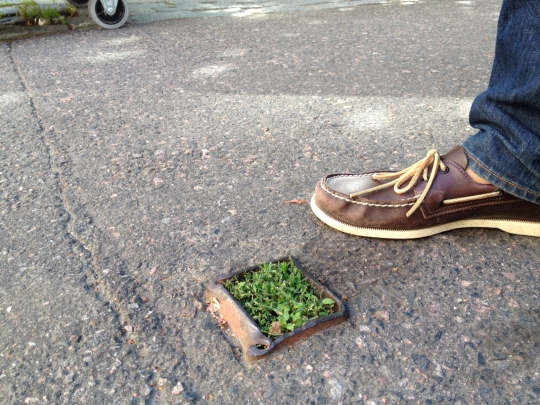
Helsinki's smallest park. A moment of pure joy. No explanation needed and none available.
Speaking of new parks in town, the week's haul of Brickstarter-shaped doings included Dan on the horn with the Guardian, resulting in this excellent article about crowdfunded urbanism including Brickstarter. Maija continues her diligent and careful documentation of other projects that overlap with the Brickstarter conversation. Having worked through all of the examples we could find in Finland, she is now turning her attention to international precedents and analogues. Meanwhile, we've had a few sessions with the larger project team including Erkki and Kali to balance out the portfolio of mini-projects under the Brickstarter umbrella.
Dan tweaked the Brickstarter introduction to make it more clear that we are working towards a prototype or a sketch of the service, and not intending to develop and operate a service ourselves. Attentive readers will remember that last week we were assessing a variety of scenarios for next steps, and that discussion continued this week. We're hoping to have some decisions here sooner rather than later, and when we do it will be easier to be explicit here about where Brickstarter is headed.
Kalle's video editing spilled over into Week 179, but we won't give him a hard time about it since he had never used Final Cut before last week. How's that for a learning curve! We finished a draft of the Open Kitchen call for applicants video and have sent that to Antto and Elina for comments. We're planning to begin accepting applications the week after next and getting the video nailed down is one of the larger outstanding to-dos. Lots of other to-do items before then, including minor things like crossing the tees and dotting the eyes on the wording of the dual language Finnish/English application. Oh, but before that we have to finalize the application process… and write it all up.
On a related note, congratulations are due to friend-of-HDL Cynthia Shanmugalingam and her partners over at Kitchenette. They're just launched a street food incubator programme based in London and we will be following along with great interest.
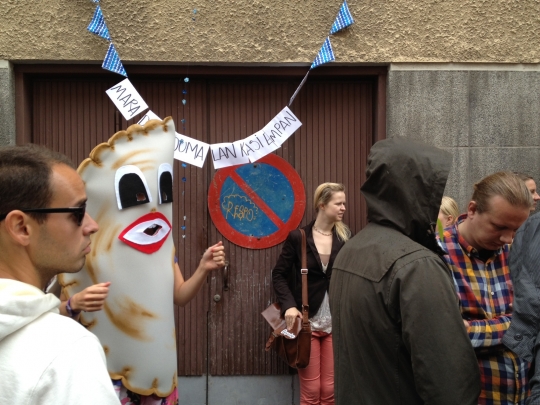
Restaurant Day happened again. Note to would-be amateur restauranteurs: dancing, human-scale versions of your foodstuffs are a surefire way to draw a crowd. Delicious empanadas also help.
Last on the project rundown is HDL 2012. We're operating on a couple different wavelengths at the moment: Dealing with near-term logistics for our third and final case session in Copenhagen next week, beginning to coalesce the content from the four cases we've already heard from, and ramping up the pace on logistical and content development for the culminating session in Helsinki. Venues, printing timelines, writing rotas, invitations, and moments of "why are we doing this?" are in the stew right now. We know why, of course, but we've been revisiting the framing of the discussion—in a healthy way.
My bedside reading list has been forming useful bridges to the daily work including, in particular, this assertion put forth by Richard Sennett in The Craftsmen [sic]:
"We are more likely to fail as craftsmen, I argue, due to our inability to organize obsession than because of our lack of ability."
The best way to rectify that is to organize our obsessions, no? With HDL 2012 we are looking at public sector innovation and trying to codify the crazy.*
*Only those crazy in a good way.
Signing out of my hotel in London today I made the mistake of putting the date down as September. Not yet, Bryan. Not yet. But this calendar mishap does reveal my state of mind. As our projects become more concrete new details emerge. New things to be taken care of, things to be considered, and somethings things to be deliberately ignored. But anyways, a lot to keep track of.
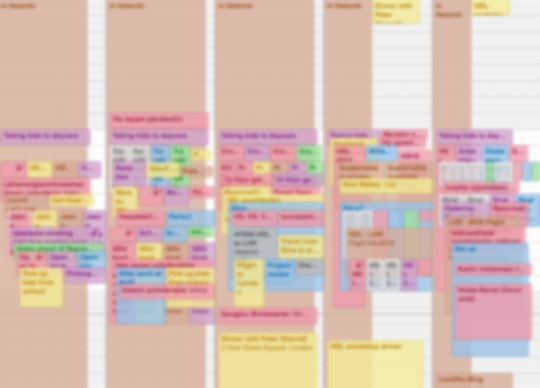
Team calendars are an indication of what our life is like right now
Maija and Kalle have been buzzing around making movies. Maija and another Kalle were shooting a pitch so that we have some plausible content in place when we release the Brickstarter mockups as clickable pages (soon!). Kalle spent an afternoon with Antto Melasniemi in Tukkutori filming the call for applicants video for Open Kitchen. They're both now heads-down editing.
(Aside: we've been watching lots of pitch videos on Kickstarter and elsewhere to learn what makes them effective. This is one of the gems we came across:Informative, unique, and hits exactly the right tone for their audience, one suspects)
Open Kitchen is seeing a smörgåsbord of activity, suitably. We're (still) wrapping up contracts, commissioning work on the brand and logo, booking ad space for the fall, and finalizing the application process so we can open that at the start of September. Elina and Antto have a good feel for most of these, and collaborating with them on the project continues to be a joy.
Although we like to do things in the open, and this project even has "open" in the name, it's kind of nice that there is not much of a public presence for the project just yet. Beyond the book we have not released many details which means we're not having to answer lots of questions. In September we will publish the call and this will change, but we'll be ready.
Brickstarter, on the other hand, has been getting tons of attention. This is all immensely positive, of course, and we've been happy to see interest from across Europe, North America, and elsewhere. Marco, Justin, Dan, and I spent an afternoon out of the office sketching scenarios A through D for Brickstarter (more like A through X).
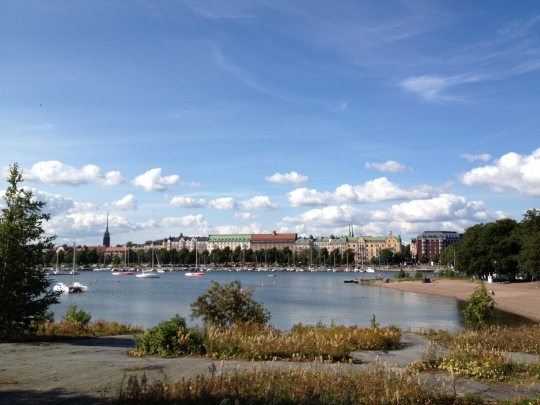
Helsinki doing what it does in summer
As we decide next steps we're balancing scenarios based on our understanding of the needs of citizens and municipal governments, Sitra's abilities, and what sort of interest we can attract from partners and collaborators. Do we build Brickstarter as a running service? If so, who will operate it long term? Do we build half of it and ensure a good handoff to another team? Maybe, but who will that team be? These questions have been part of our dialog since the start but we're approaching a decision point, thus scenarios A through D.
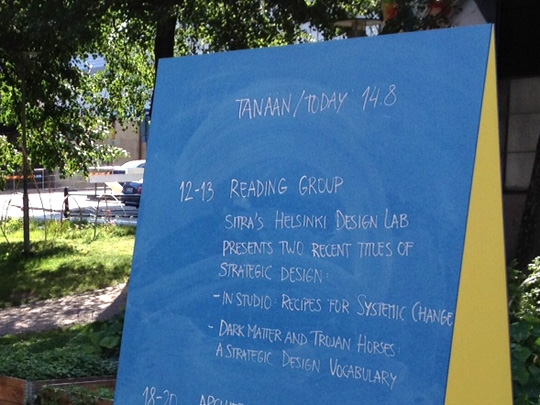
In the middle of the week Dan and I did a book reading at the Paviljonki. Sure is going to be sad to see it close up for good in September.
And then there was London. Marco and I came here under the auspices of HDL 2012 to learn from Nesta and IDEO about how they make innovation happen. Our focus this year is on stewardship, or the craft of innovation. During the session Philip Colligan pointed us to W. Brian Arthur who is very compelling on the subject of "Deep Craft" (conveniently, coincidentally, transcribed by Matt Jones):
Deep craft is more than knowledge. It is a set of knowings. Knowing what is likely to work and what not to work. Knowing what methods to use, what principles are likely to succeed, what parameter values to use in a given technique. Knowing whom to talk to down the corridor to get things working, how to fix things that go wrong, what to ignore, what theories to look to. This sort of craft-knowing takes science for granted and mere knowledge for granted. And it derives collectively from a shared culture of beliefs, an unspoken culture of common experience.
I like this a lot because it encapsulates in a more elegant way something that I've been calling cultures of decision making. As we study the craft of public sector innovation—this particular culture of decision making that's emerging—we're approaching it as anthropologists might. In conducting these sessions with high-performing innovators we're attempting to understand the rituals, trinkets, roles, and spaces that populate their work. And often, I should note, our own.
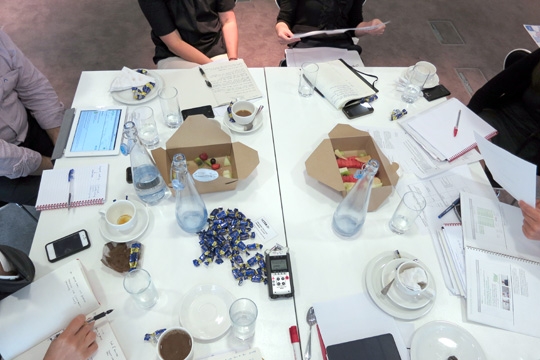
The 18 pages of dense notes in my sketchbook are testament to the caliber of conversation. Thanks to Philip Colligan, Katy Bentham, and Melani Oliver of Nesta; John Craig of Innovation Unit; and Hailey Brewer and Suzy Stone from IDEO. Many thanks also to Nesta for hosting the sessions, including a top notch picnic!
This took longer than it should have. We've been back from the summer holidays for a solid week now, but as you can see there is some lag getting back into the habit of writing.
Last time I was just heading to New York to meet up with Justin for our first of three HDL case study sessions. We had a very packed day with Rosanne Haggerty and her team from Community Solutions sharing their work in Brownsville and Rodrigo Araya and Alejandro Aravena reflecting on the reconstruction of Constitución. Justin and I are now processing those conversations and distilling it with the goal of writing two short case study papers.
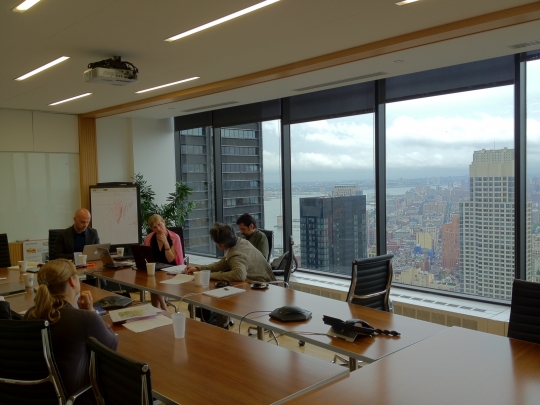
Monitor kindly loaned us one of their stunning conference rooms
On a meta level the session was instructive as well. Despite careful planning and logistics (and excellent facilities thanks to the Monitor Group), the agenda for the day was too ambitious. We spent more time on introductions and basic context than expected and felt the crush of the clock at the end of the day. In the next two sessions we are going to attempt to spend a day and a half total. Try, learn, adjust, repeat.
Next week Marco and I will zip to London to conduct the second (day and a half!) session, this time with Nesta and IDEO. Nesta are bringing their Creative Councils project and IDEO are going to share some work they've done with the US government. In other words, there's not a direct overlap in terms of content. Huh?
In organizing these case study sessions we've paired teams with slightly different content focuses as a way of ensuring that the conversation is about how innovation gets done. Our hypothesis was that by pairing up mismatched content the overall conversation would naturally veer towards the intersections between the two groups, the methods and approaches that they use to move forward. The first tentative evidence we have from the session in New York is that our hypothesis was correct: the conversation swayed back and forth between 'what' and 'how' but the room was most engaged and excited when discussing the practices rather than the specific details of poverty alleviation or urban planning.
With each case we're trying to understand the work on two levels: the 1:1000 high level overview and the 1:1 on the ground reality. The high level view is about getting the narrative of the project in order before we zoom in to look at specific important and instructive moments where something critical happened such as when funding was secured, where a key stakeholder gave their buy in, where the scope of the project changed, and so on. How did the project prepare for this, how did they weather it, and how—ultimately—did they come out the other side successfully? The impetus for this as a focus comes from a number of threads, but we can sum it up quite simply with a quotation from none other than the American boxer Mike Tyson:
Everyone has a plan until they get punched in the face.
Back here in Helsinki, our Brickstarter and Open Kitchen projects are revving up. We were very pleased to see a nice piece on Brickstarter on Wired.com last week and that gave up the impetus to do a bit of a press roundup.
Dan and I were in Kalasatama to meet with Antto and Elina about Open Kitchen. That is trending in the right direction and is about to get very busy. Next week we'll film a quick video as a Call for Applicants that should go public in early September. We want to make sure the eyes are dotted yadda-yadda-yadda before it all goes out the door, so more on this soon.
This year's Flow Festival features an installation by Nene Tsuboi and Åbäke depicting a number of unbuilt designers for Helsinki's Grilli kioskis, the city's hot dog stands. They asked me to contribute a micro manifesto about food and the street, to which I submitted the following. See also: Helsinki Street Eats and Dan's earlier piece for Artek's Manifest I. Lots of manifest(o)s.
The most visible food in the streets of Helsinki today has already passed through the human body and been reborn into the world as site specific installations of urine and temporary constructions of vomit. While we're a city that's comfortable with pissing in the street, eating is puzzlingly hidden. It's mostly reserved for the drunken stumble to a grilli (which everyone hopes to forget the next morning) and slurping porridge in a tori (where one is hidden amongst the ubiquitous orange tarps).
Despite Helsinki's architectural commentary by bodily function we have all the right ingredients for an urban culinary renaissance. In 2012 Nordic food is the envy of the world and Helsinki's specific architectural heritage gifts it a variety of iconic lippakioskis and grilli structures waiting to be linked into a city-wide network of grub hubs. If only they served something worth remembering.
Oh but they will! Bring on the curry siika, poro bratwurst, and birch soda. This is anything but a trend. It's a sign of a culture that embraces diversity, in a meal and on the street. Street food is about relearning how to make the city our own not just for occasional festivals but a real—and really delicious—part of everyday life.
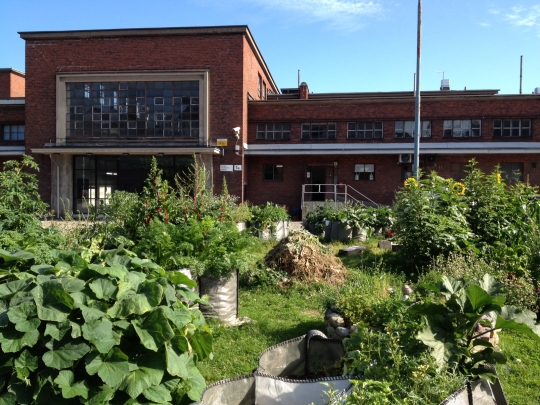
Tukkutori's edible garden is blooming very well in a series of grow bags. This will a great addition to Kalasatama when it's finished later this year.
In both Brickstarter and Open Kitchen we're increasingly turning our attention to how the projects will grow beyond Sitra. How far will we take the work? When do we look for partners to carry it forward? What does that handoff look like? This is a necessity of the work, on one hand, but we're also trying to use it as a point of innovation in and of itself. From the perspective of strategic design is there a different way to transition projects from in house to out of house, for instance? Early days on these thoughts.
Marco was quoted talking about Low2No and our Design Exchange Programme in the July issue of Wallpaper Magazine. They don't seem to have the article online, but the author has posted the full text on his blog. And speaking of Design Exchange, our second placement has started work at the Helsinki Department of Social Services. She will introduce herself soon on the DEP blog.
Juha Kronqvist is himself an embedded designer doing good work with a hospital in central Finland and Aalto University students. Recently he released this video that shows some of their paper ptototying of hospital spaces. You can also read more on their blog.
Lately we've been holding our project meetings in a construction site. The renovation of Sitra's 12th floor that we have been working on for a couple months now is finally complete. The space is light, bright, flexible. Personally I'm very happy with the way it has come together. It's definitely a step forward for our facilities and will take some getting used to, but the net effect is that we now have the kind of collaborative work environment that was hard to come by previously in the Sitra tower. Once people have settled in to the space we'll be posting some further thoughts on the relationship between workspaces and working cultures.
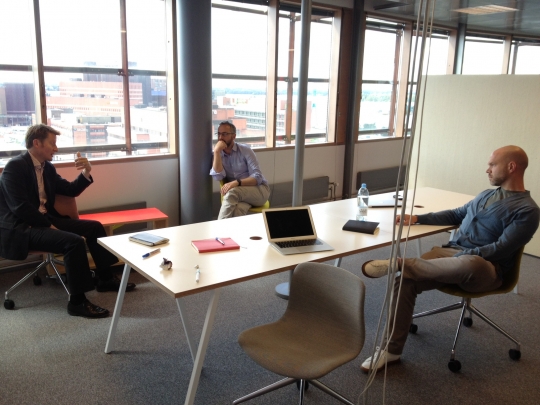
When this was taken there was still some electrical work to be done, as you can see
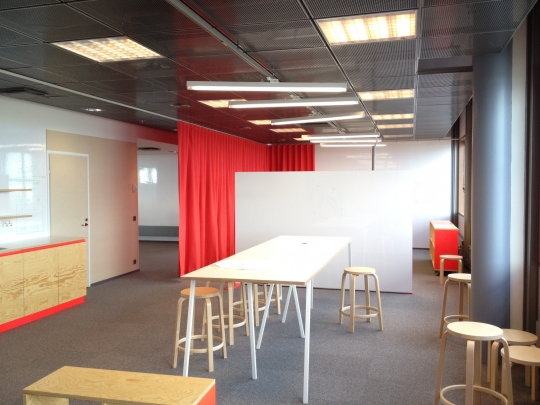
Our new kitchen, featuring an invisible coffee machine (until we get a new one)
Last but not least, if you are in Helsinki on Tuesday, August 14th you are very welcome to stop by the Paviljonki located between the Design and Architecture museums in Ullanlinna for a double whammy of strategic design.
Dan will be there to talk about his Strelka press book Dark Matter and Trojan Horses: A Strategic Design Vocabulary and I'll be sharing In Studio: Recipes for Systemic Change. Come have a coffee with us!
As I write this, my mind is a few days in the future, thinking about Friday at 9:30 when we will kick off "official" HDL 2012 activities. That's a rather serious-sounding way of saying that Justin and I will spend a day with six smart people in a nice room. Where HDL 2010 was about distilling a grand challenge into an actionable strategic intent, Helsinki Design Lab Global 2012 is…
about stewardship; or in other words, how innovative things get done. With the global conversation increasingly invoking the (re)design of systems, institutions, markets, and even the social contract, HDL 2012 is an opportunity to reflect upon the necessary innovation required of innovation itself. How do we shape policy through projects? How do we connect strategy to execution? How do ‘clients’ of innovation maximise their value and agency?
New practices, new themes, and even new vocabularies emerge as this community grows. Helsinki Design Lab 2012 is an opportunity to take stock of these emerging practices and begin to codify new ways of doing.
When we wrote the first three HDL case studies back in 2009-2010 we did so because the best innovators in the world rarely have the time to step back from their work and codify it in ways that others can make use of. And understandably, it takes time to reflect and then package those reflections, and that's time which can be used doing more good work! So beginning with those cases and now continuing with what we expect to be six more cases between now and October, we are using HDL 2012 to gain a deeper understanding of how innovation is accomplished by different cultures of decision making.
It's a comparative study of innovation practice, really. We've invited two public bodies, two NGOs, and two private entities to contribute one project each. Together these six practices span Europe, North America, and South America, and they work in areas ranging from community planning to business oversight.
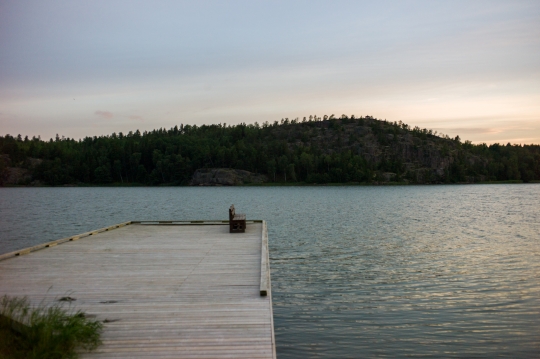
Summer in Åland, the archipelago between Sweden and Finland
The sheer diversity of the group was one of the things we were equivocal about for some time. A typical comparative study might seek to minimize the variables to down one—a range of public, private, and third sector organizations all addressing homelessness, for instance, and all in the same geography. But this year we will be juggling multiple variables that change from case to case, and the reason is rather straightforward: we have tried to recruit from the best of the best in public innovation, and that means accepting a more diverse set of projects. It would be crazy to assume that the best of contemporary practices are captured within any single field.
We're also experimenting a bit with the format. Rather than Sitra conducting one-on-one case studies, we're bringing together two cases at a time and asking the teams to help us interview and analyze their counterparts. This means that we'll have extra brain power in the room to ask the right questions and evoke the right discussion. Our hypothesis is that having practitioners interview practitioners will help us keep our heads out of the clouds. Someone who has been-there-done-that has a unique ability to stop things and ask questions like OK, but how did you really pull that off?
The kind folks at Monitor Group + Doblin have graciously loaned us one of their conference rooms (thanks especially to Helen Walters!) where we will spend the half the day discussing the reconstruction of Constitución, Chile after the 2010 earthquake and tsunami and half the day focusing on the revitalization of Brownsville, NY. Alejandro Aravena and Rodrigo Araya will be sharing their experience with the work in Chile and Rosanne Haggerty will be joined by a number of people from her team on The Brownsville Partnership. We're lucky to have been following their work for a while, and personally I'm looking forward to getting a good chunk of time to understand their recent efforts in depth.
Friday will be the first of three case sessions leading up to a culminating event in Helsinki in mid-October. It's going to be a small affair with only about forty people, but as always we will do our best to make sure that the learnings are shared as widely as possible.
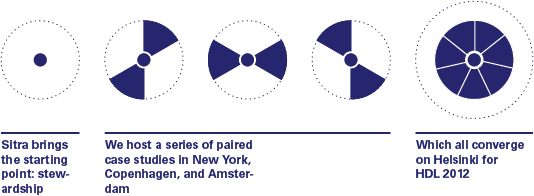
Outside of the intensifying work on HDL 2012, I've been hosting the occasional group for a talk at Sitra (thanks for coming, EGOS) and working on some back burner projects (more on those in a second). Kalle is in the office tending to our food work which now has the beginnings of a web presence. Marco, Dan, Justin, and Maija are enjoying various depths of the summer holiday.
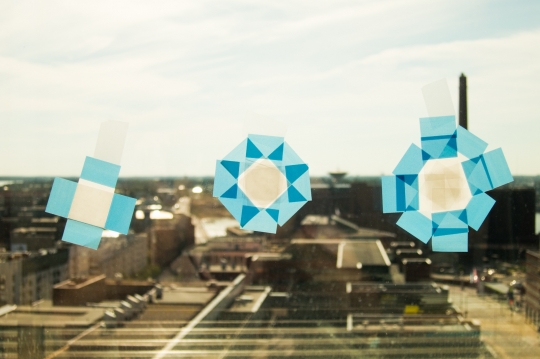
Clear evidence that Marco has been in the office, and so have his kids.
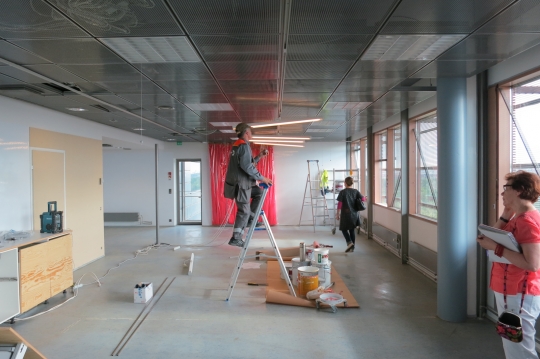
The renovation project we've been working on in the office continues to inch forward. I'm looking forward to this being done.
At the risk of making us sound obsessed with codification, I've been taking advantage of the slow pace of the office in summer to revive a long overlooked "manual for creative collaboration." We had the opportunity a couple years ago (!!!) to commission the Open-Ended Group to write a pamphlet on how to get the most out of collaborative work, but we've been so busy with everything else that it's only now that I've found the time to open those files again. It's good, simple, clear text and I've allowed myself the indulgence of devoting time to experiment a bit with the layout, taking inspiration from the lovely Bauhaus typography I saw at the Barbican in London recently. Eventually this will sit alongside the Design Ethnography field guide as a small practical manual.
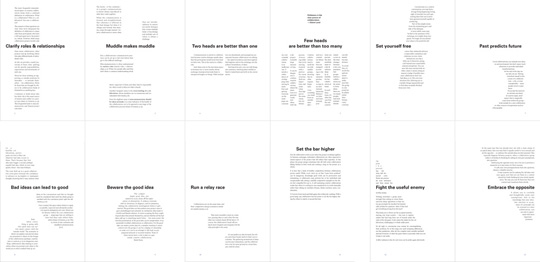
Draft layouts of the collaboration booklet.
After spending two extremely intense days in Copenhagen with a group of people running various "design labs" at the beginning of the month, I'm once again struck by how much shared territory there is in the various approaches, and yet such significant differences in the way that different groups describe their work. That these practices are being cobbled together from a combination of social science, design, media, entrepreneurship, public administration, and other backgrounds means that a common ground doesn't come naturally but must be willfully created. The lack of shared vocabulary makes the true overlaps harder to see and positive differences harder to highlight.
Take "participation," for instance. Different groups use the term "participation" variously to mean working with people to create novel ideas, conduct due diligence on proposals, or secure wider buy-in for a course of action—and sometimes a combination of these. But those are three very different ways to use "a bunch of people in a room doing something together," each with their own nuances, pitfalls, and benefits. No wonder Markus Miessen refers to the Nightmare of Participation!
Thanks to Banny Banerjee, Christian Bason, Tim Brodhead, Luigi Ferrara, Sam Laban, Cheryl Rose, Frances Westley for the generous discussion. There will be a summary paper coming from that meeting which we'll post here when it's available.
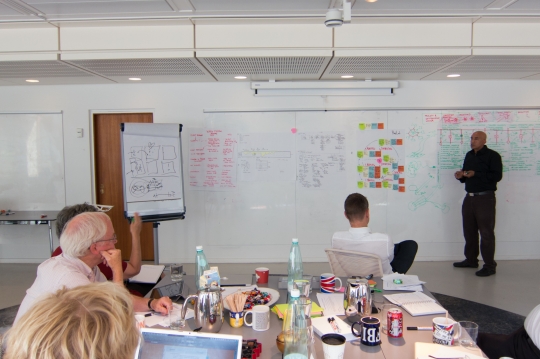
Banny explaining the Stanford d.School design process.

There's a CNC fabrication shop in that basement. Copenhagen knows how to make a courtyard.
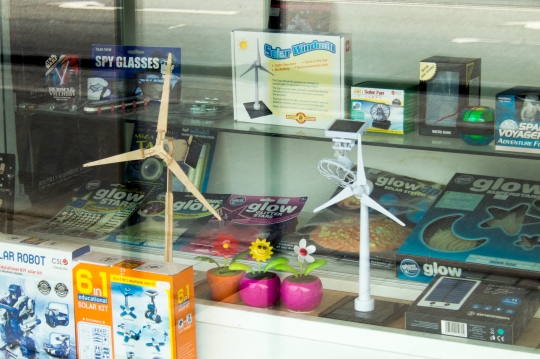
That you can buy mini turbines at a toy shop in Copenhagen says a lot about deeply renewable energy has soaked into Danish culture.
For a final and more entertaining note on collaboration, codification, and getting things done, I leave you with this video introduction for new employees of New York-based artist Tom Sachs' studio.
